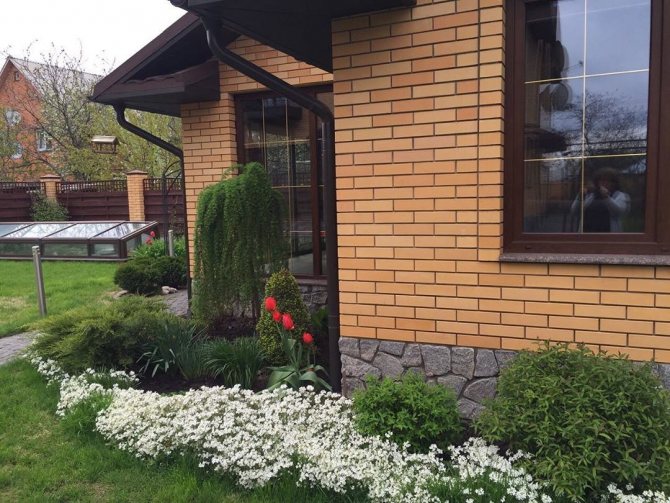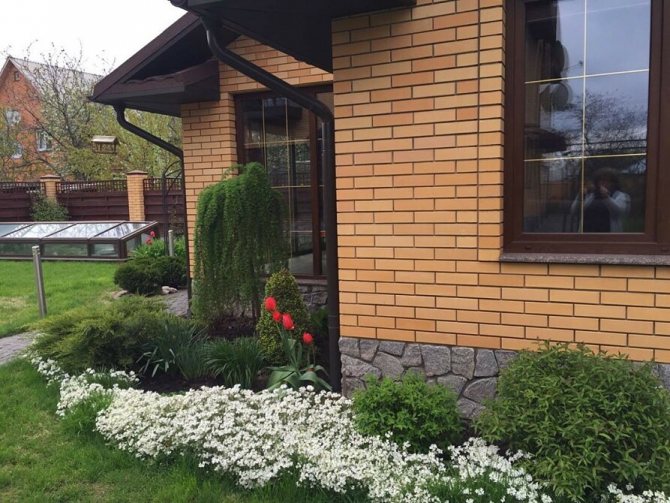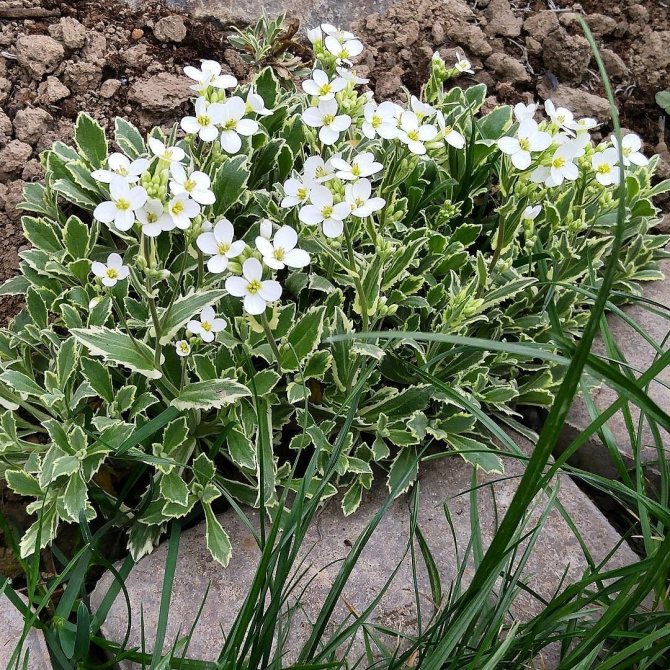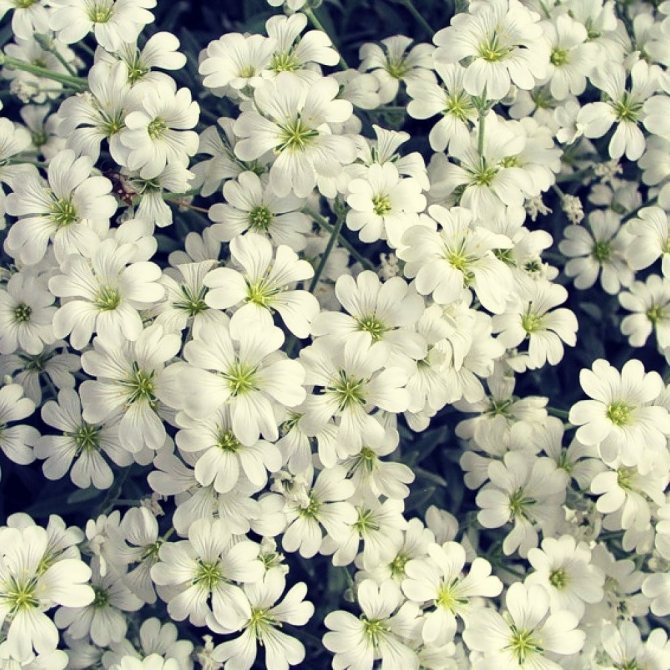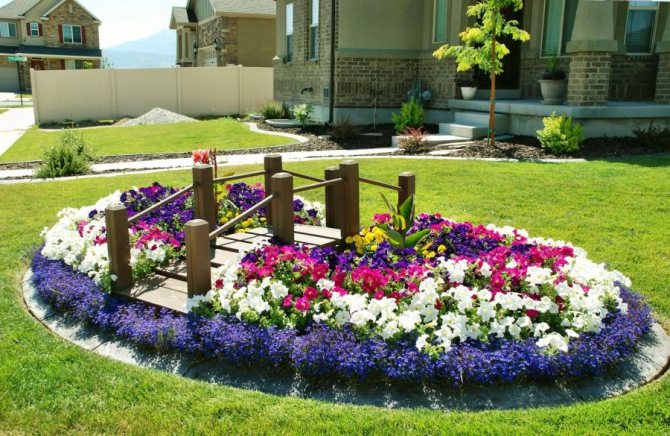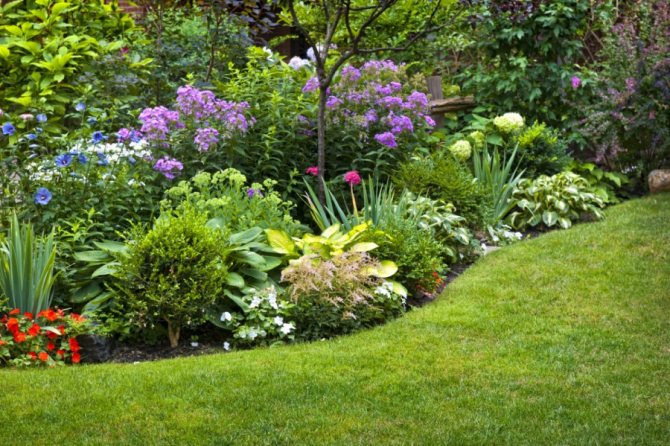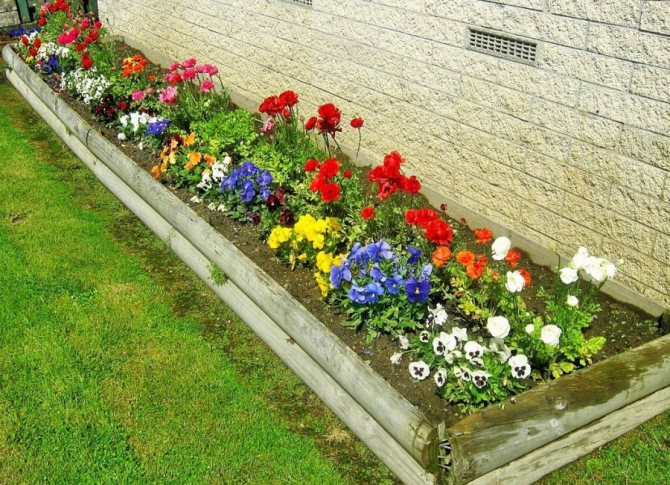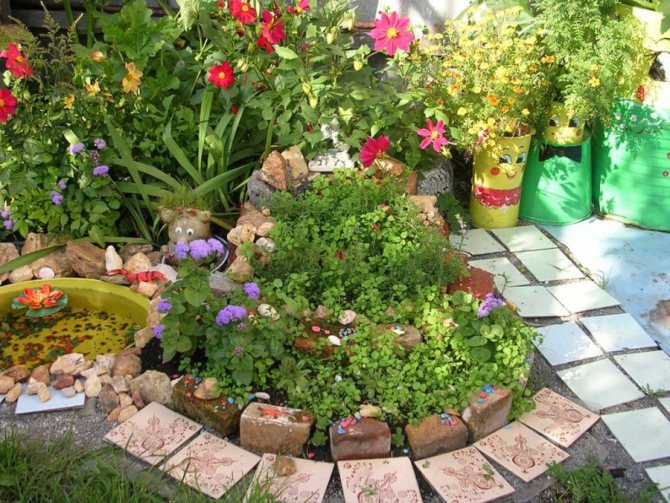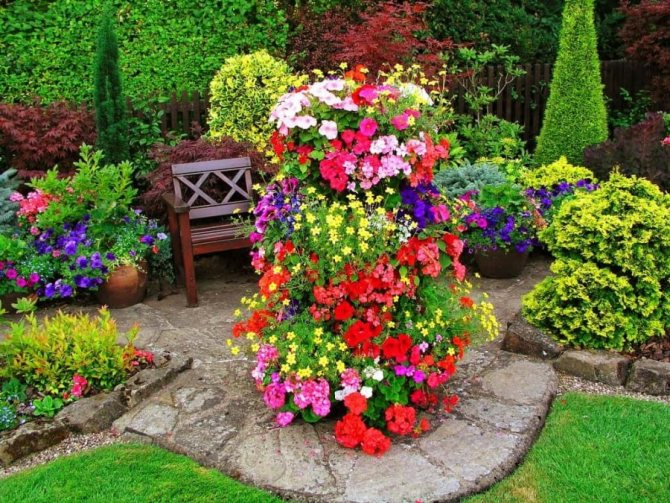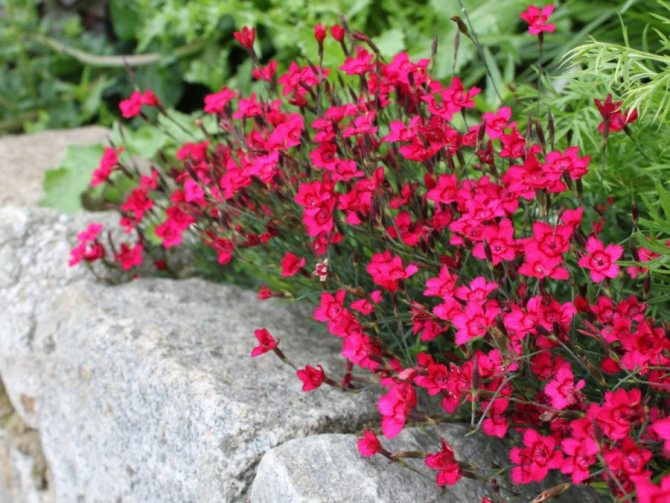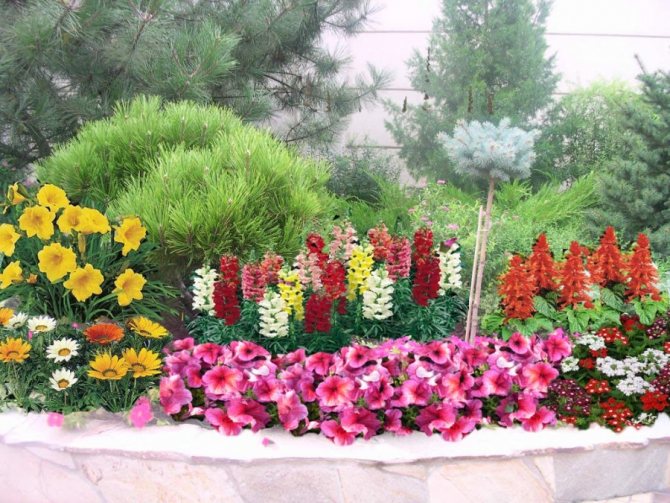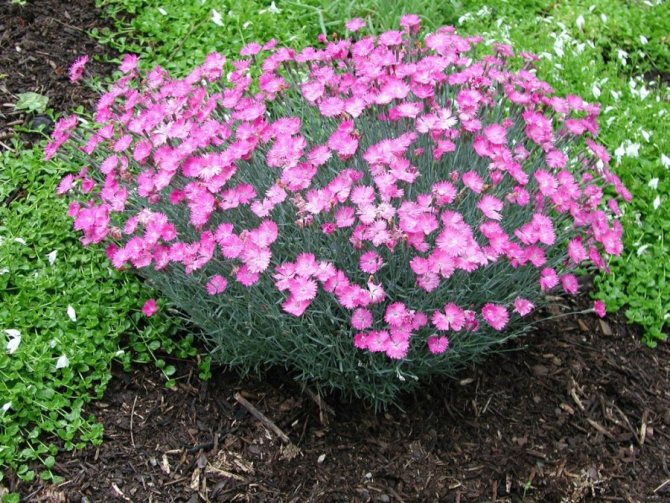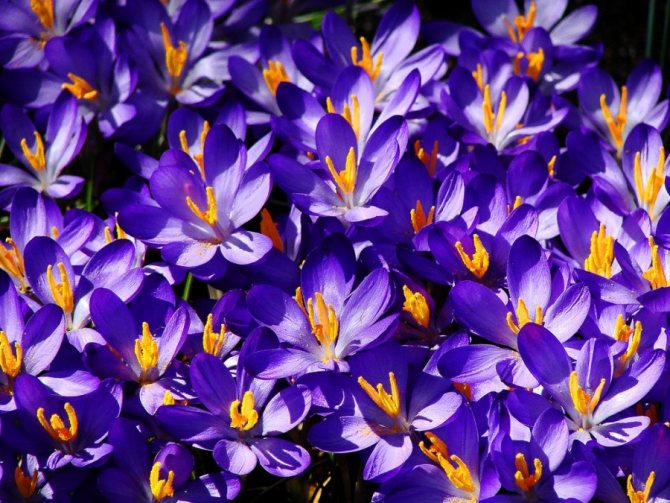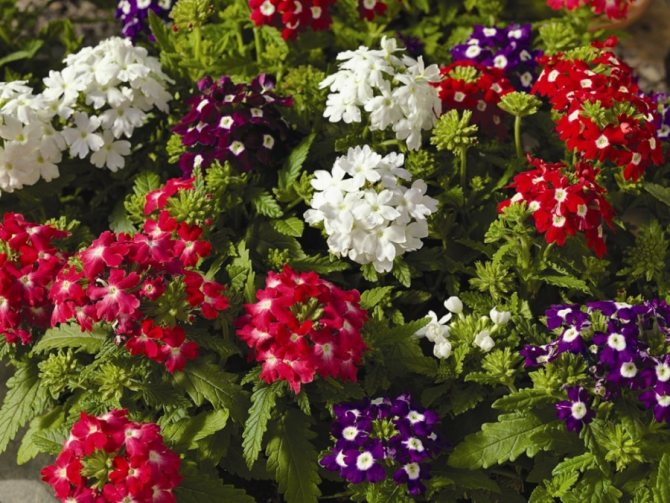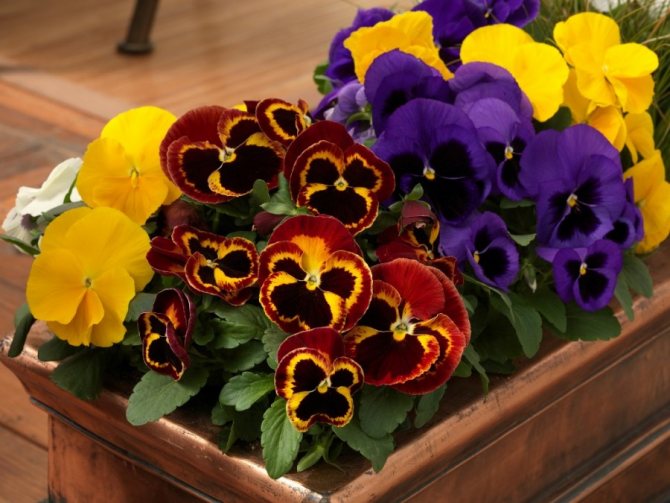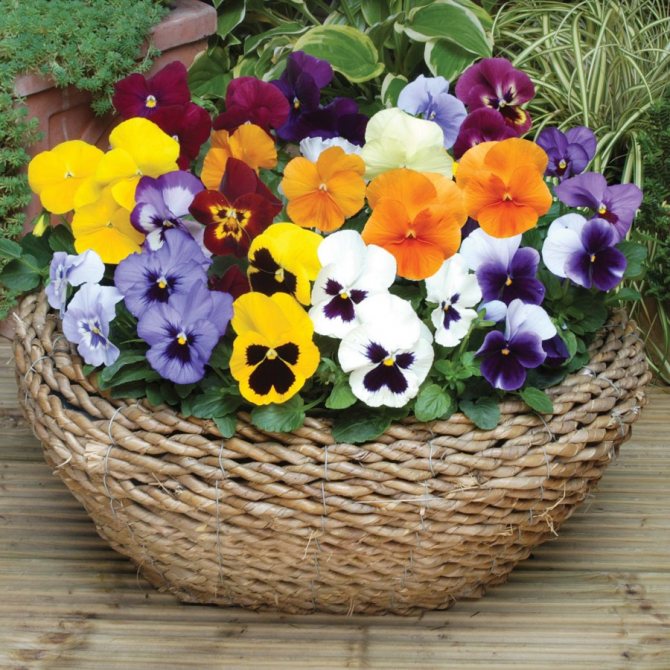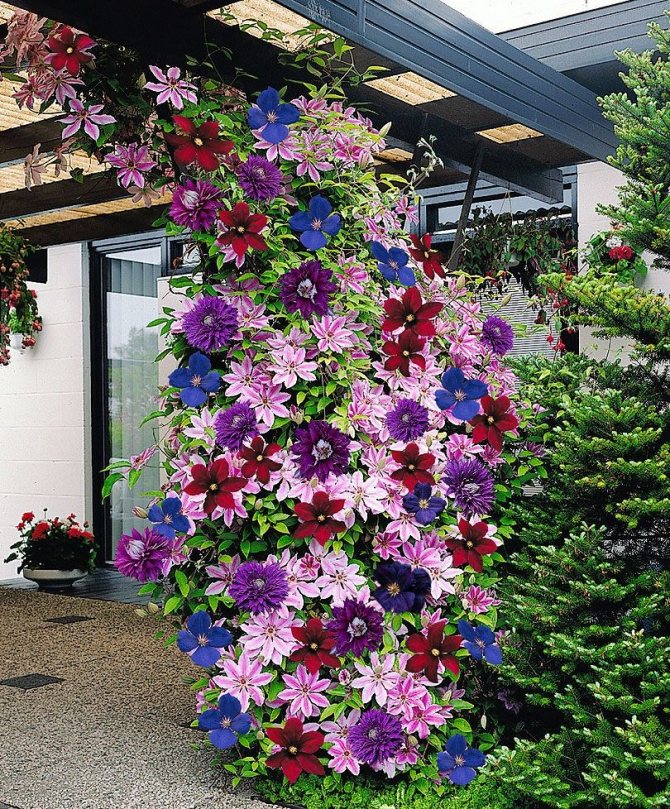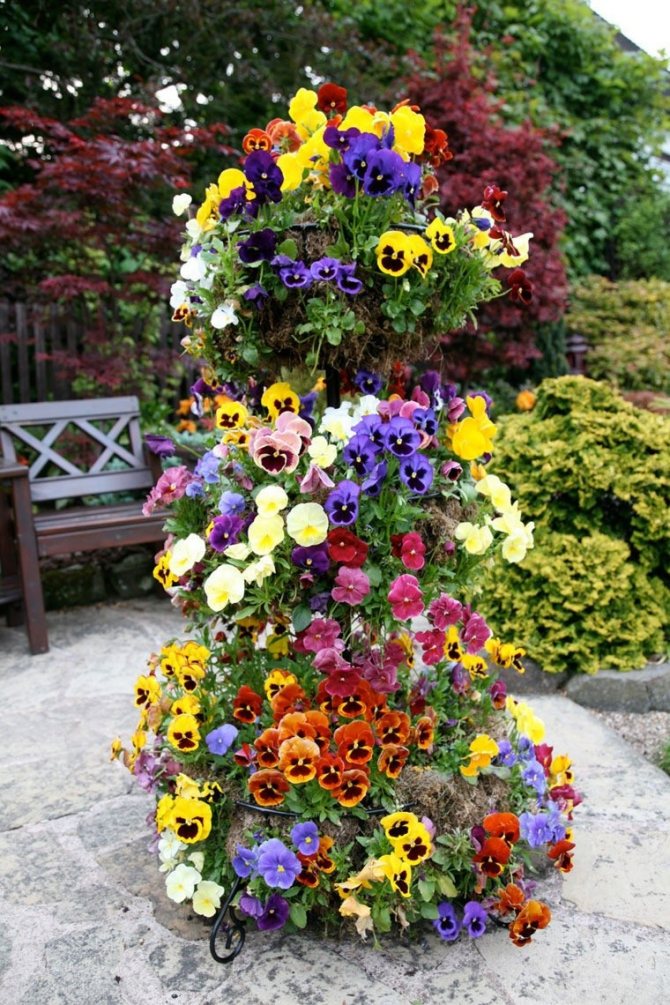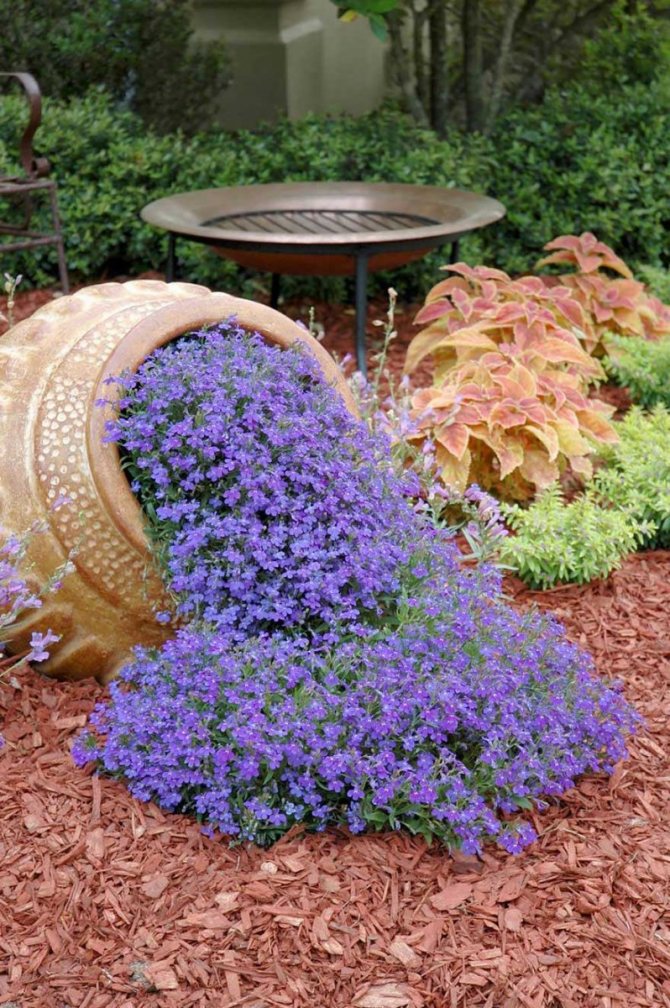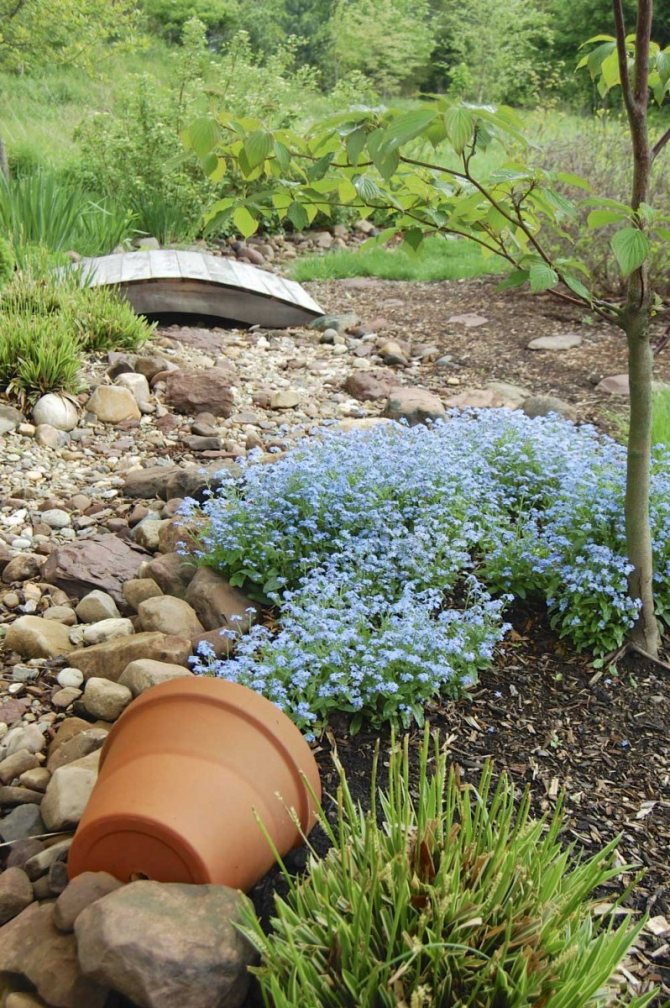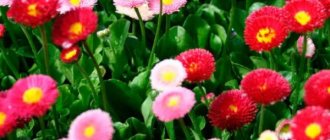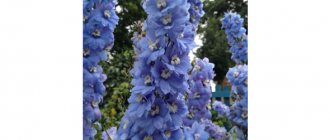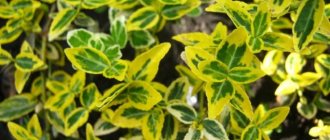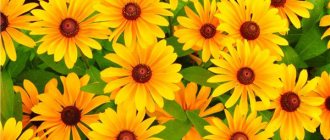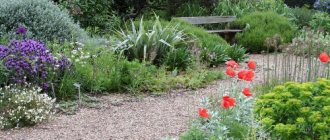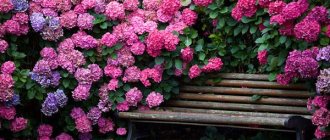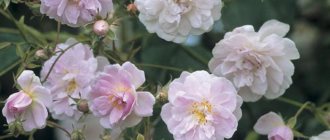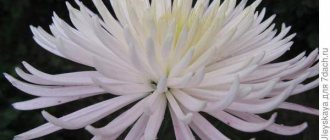It would be just silly to have a piece of land and use it only for garden planting. Even on a small piece of land, you can find a place to organize a recreation area, plant ornamental plants for the garden, put up a gazebo or at least a comfortable bench.
The choice of beautiful and unpretentious plants is so great that they can be selected for any climatic conditions, site size and in accordance with your preferences. These are trees, shrubs, perennial flowers and herbs.
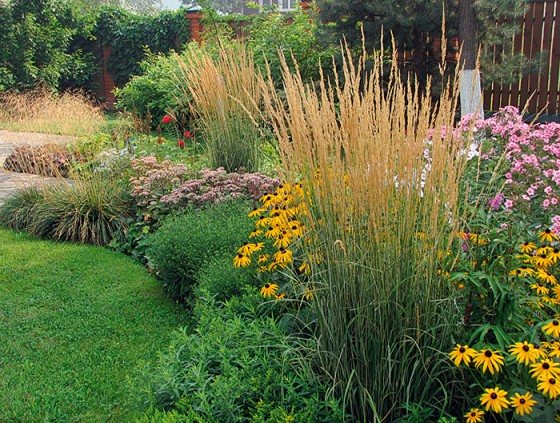
A beautiful garden is a place you don't want to leave
Spruce
Evergreen conifers are among the most popular in the design of a summer cottage. The most common types of spruce that are well suited for growing in the country are European and prickly.
European spruce in height it can reach up to 30 meters, and in width its crown spreads over 5 meters. The shape of the crown is conical. By the age of 10, it grows slowly, then in a year it can grow as much as 70 cm.
The most popular ornamental varieties of this type are:
- "Akrokona" - about 3 m high and 4 m wide, has dark green needles, below the crown spreads widely and narrows significantly towards the top;
- "Inversa" - it is also called weeping, since the branches fall from top to bottom, like a willow; can grow up to 7 m in height;
- "Maxveli" - dwarf variety, has a spherical shape, yellow-green needles, reaches no more than 2 m in height and width;
- "Tompa" - a very beautiful dwarf variety, fascinating with a bright green decorative crown with a light green tint; in height reaches up to 1.5 m, in width - up to 2 m.
Spruce prickly, in the absence of pruning, can grow in height up to 25 meters. It has an attractive, low-hanging crown. The needles of this species are very sharp, maybe green, blue, gray. Prefers well-lit places, loose, moderately moist soil.
Among the decorative varieties, the most popular are:
- "Fat Albert" - grows up to 10-15 m, needles are gray;
- "Fastigiata" - blue spruce with a narrow conical crown shape;
- "Guspi" - has a very beautiful bright blue needles. Grows up to 11 m.
The most suitable period for planting seedlings is summer. They love well-drained, loose soil and lighted areas. Common European spruce will also thrive in light shade conditions.
Important! The first two weeks after planting, young seedlings need to be shaded from the sun so that they do not burn out. It is also recommended to cover seedlings of decorative varieties in the fall from future frosts.
Spruce roots do not grow deeply into the ground, but grow in breadth close to the soil surface. Therefore, a distance of at least 3 meters must be maintained between trees. These plants should not be placed next to fruit trees.
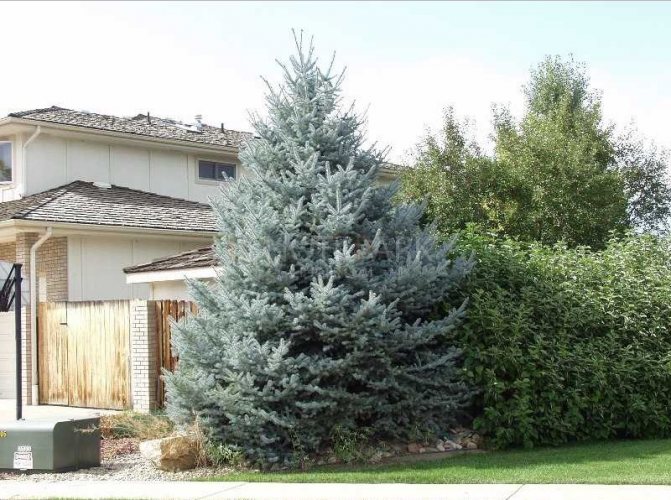

Ate does not like too moist soil, so they should be watered only in drought, once every 10 days. The crown of spruce lends itself well to pruning, so that beautiful shapes can be formed from it.
Tall perennials
Such plants can be planted in separate groups or as a spectacular background for multi-tiered compositions, as in the photo. Among tall perennials, there are both flowering and plants with beautiful lush leaves.
Advice! Many varieties of perennial tall plants are distinguished by the duration of the growing processes, so they begin to bloom quite late - in the middle of summer.
In the penumbra of the garden, you can plant tricyrtis, whose flowers resemble orchids or lilies. This perennial begins to bloom in early July, and pleases with its appearance - until the frost.
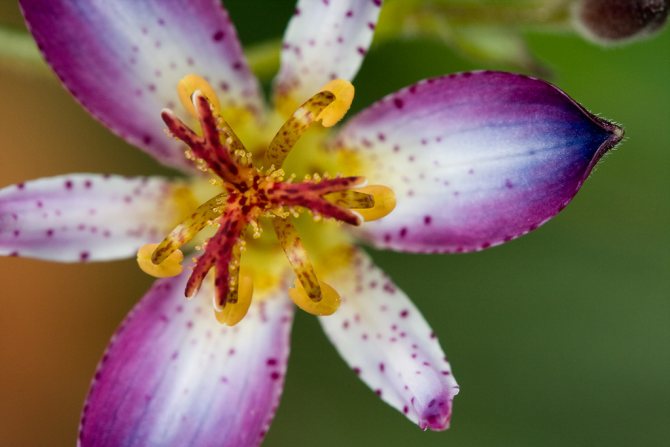

Tricirtis, also known as garden orchid and toad lily
Lupins are loved by many gardeners, these unpretentious flowers look very bright and are distinguished by a huge selection of shades. These plants look good when planted in separate groups, and in a floral ensemble, they are ideally complemented by smaller flowers. Among the tallest garden plants, willow sunflower stands out. Its large saucer-shaped flowers of a golden brown hue are visible even outside the site, since the height of the stems reaches 2.5 m.
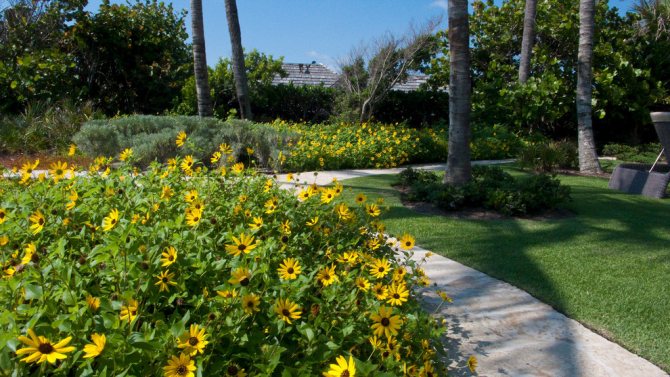

Willow sunflower: blooms in August-September
Echinacea with rudbeckia (golden balls) will help to give the flower garden structure by filling in the background. Their inflorescences are in perfect harmony with the rest of the plants. They begin to turn green in early spring, easily tolerating wintering. Rudbeckia must be monitored so that it does not overgrow the entire garden, as this flower has weed habits.
Frost-resistant echinacea purpurea
In different parts of the world, rudbeckia gets different nicknames: in our country it is known as a fire or gold ball, in America - as "black-eyed Susan", and in Germany as "sun hat"
Evergreen honeysuckle
Honeysuckle is one of the most adorable evergreen shrubs for the garden. Throughout the summer, it blooms with beautiful raspberry inflorescences, and in winter it pleases the eye with rich green foliage.
Honeysuckle bushes - curly, can grow up to 3 meters in height. The plant has wide oval foliage. In length, the leaves reach up to 8 cm, in width - up to 5 cm.Inflorescences are odorless, rolled into a tube and hang from the shoots in the form of bells about 5 cm long. The color of the flowers is mainly dark pink outside, crimson, inside - light yellow. In addition, there are varieties with red and yellow buds. After flowering, small bright red berries form on the shoots.
Young seedlings are planted in open ground in the spring, after the end of winter frosts. The plant loves open, lighted, windless places. The most suitable soil will be loose, moderately moist soil.
For planting, they dig a hole up to 40 cm deep (it is recommended to lay a layer of sand and gravel on the bottom, then a little soil mixture). The plant is placed in the center of the hole, the roots are gently straightened, covered with soil and compacted a little. Honeysuckle should not be deeply buried in the ground (the neck of the root must be level with the ground), otherwise it will not grow and may disappear. For the first 14 days, a young seedling should be shaded from the sun's rays.
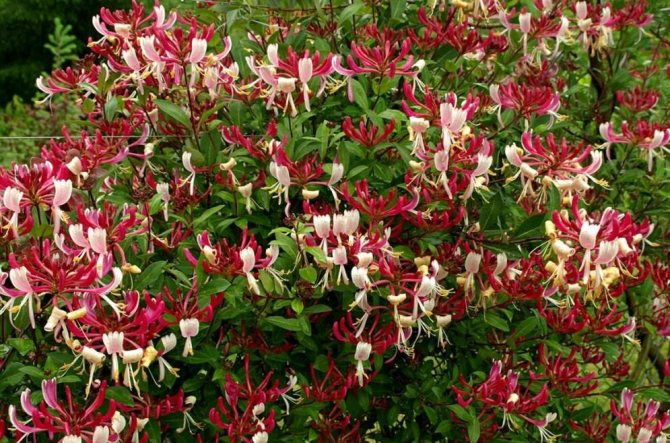

Did you know? In order for the honeysuckle bushes to look decorative and neat, its branches must be tied up, and the old
—
periodically remove to the very roots. With the correct garter and strong support, branches of an evergreen bush can be wrapped around a gazebo or a fence.
It is recommended to cover the bushes for the winter. Honeysuckle perfectly tolerates transplantation and practically does not get sick. Shrubs need to be thinned every three years.
Medium-sized perennials
The ideal solution for any garden is perennial plants with a height of 30-80 cm, and looking at the photo, you can estimate which species are suitable for a particular site.
Irises will adorn any garden. This elegant flower is suitable not only for decorating a flower bed, with its help you can effectively emphasize the reservoir on the site, plant irises near a gazebo or other recreation area. Dwarf species are good for decorating alpine slides. Depending on the variety, irises can be light-loving or prefer partial shade.
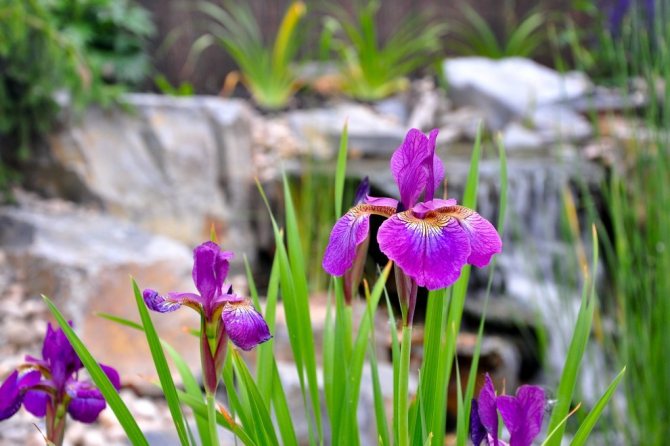

Everyone's favorite irises are hardy perennials of amazing decorativeness
One of the leaders in ornamental gardening is the daylily, which is easy to care for and has many varieties. It grows well in the shade, and beautiful leaves will complement any composition.
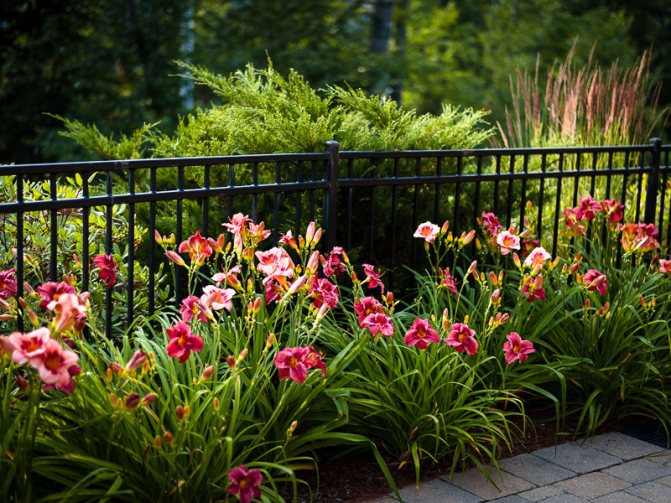

Daylilies are very beautiful and at the same time relatively unpretentious flowers. Felt best in moderate light
Peonies will become a real decoration of the garden, giving the site an elegance. Spectacular double inflorescences are painted in tones from white to maroon. In addition to tree-like peonies, there are also herbaceous ones, under this name plants for novice gardeners are hidden. Herbaceous peonies begin to bloom the next year after planting, but this lasts much less than tree peonies. Peonies are quite demanding, only mineral fertilizers are suitable for them, in addition, it is necessary to provide abundant watering.
Peonies need no introduction. They can be grown in one place for decades
One of the most popular and unpretentious flowers can be considered garden chamomile, which looks good on any flower bed. It is distinguished by a long flowering period, requiring moderate watering and the simplest fertilizers when leaving. Among the varieties of garden chamomile, you can find the following names: nivyanik, pyrethrum. They differ, first of all, in the color and size of the inflorescences.
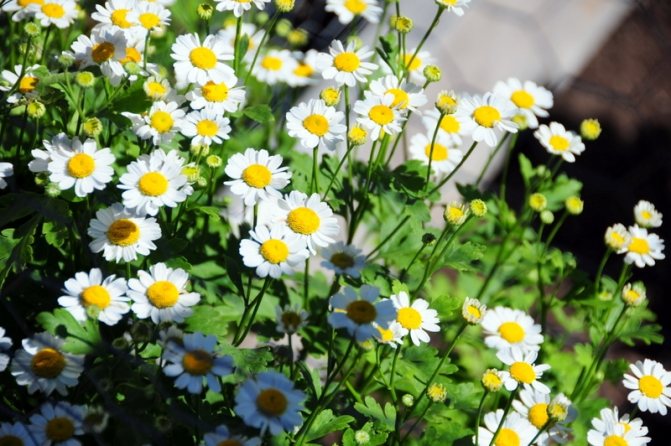

Garden chamomile is a perennial that blooms from June to the very frost
Perennial asters will give little trouble to gardeners (not to be confused with annuals belonging to the same family). They bloom until the first frost, depending on the species. Flowers can be of different shades: pink, lilac, yellow and blue. Asters are demanding on soil and fertilizers, prefer organic ones.


Astra New England
No beautiful garden is complete without phlox. These lush, colorful plants are easy to care for and weed-like in behavior, so it's important to keep an eye on their growth. Phlox have no special requirements for lighting; it is recommended to replant them once every 6 years. In the same family, dwarf phlox can be distinguished, which are suitable for decorating hills or lawns, forming a dense floral cover.
Phlox (translated from Greek - "flame") - undemanding to lighting and soil characteristics
An example of perennial plants of medium height, distinguished by beautiful flowering, are: Rhodiola rosea, Astilba, double monarda. These flowers delight with their appearance all summer, and photos will help with the choice of shades.
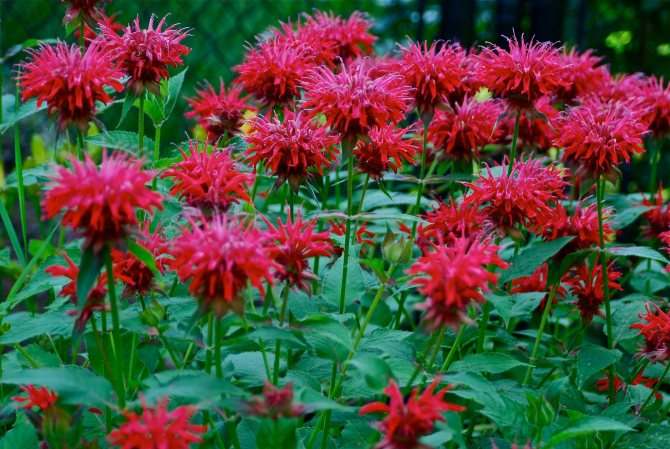

Monarda came to us from North America. The plant is very aromatic, a very large amount of essential oil is extracted from it. By the way, from natural plants, this is the only remedy that has an effect in the fight against mold.
The amazing shape of the rhodiola bush
Rhodiola rosea bloom
Cypress
The evergreen cypress hedge just can't help but captivate the look. The trees can grow in height from 1 to 25 meters. The crown is round and cylindrical. In the second year of growth, cypresses ripen cones. They have a very beautiful shape and resemble a flower bud.
Today, about a hundred species of cypress trees are known, but the most decorative representatives include:
- Evergreen cypress;
- Leyland;
- Weeping;
- Saharsky;
- Mexican;
- Arizona.
The green needles of cypress trees are soft and pleasant to the touch. In some varieties, the needles have a beautiful light green or blue tint. The fastest growing plant is Leilanda. This tree resembles a "living" column with dense symmetrically arranged branches.
Important! Cypress tolerates only slight shading, and in conditions of full shade, the crown of the tree crumbles.
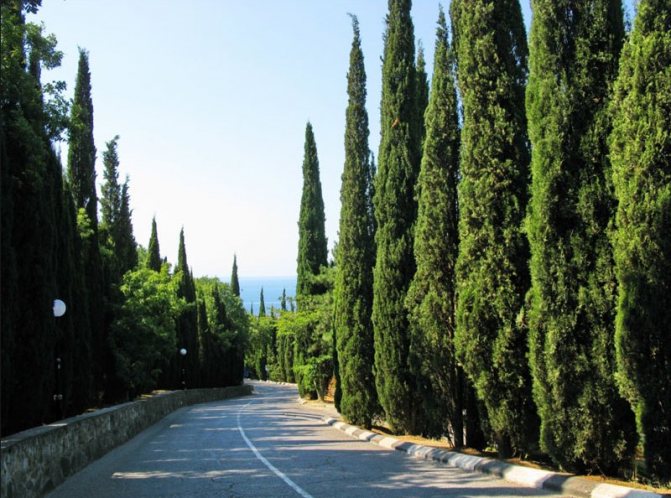

Cypress trees are not demanding on the soil, they withstand drought well, but they do not tolerate frost well. If the drought is long, the tree should be watered.To form neat bushes, pruning is carried out at the end of August. In conditions of infertile, heavy soils, it is recommended to feed cypress with a three-component fertilizer once a year. The best way to propagate is by cuttings.
Evergreen flowering shrubs
ARBUTUS
The Russian name is strawberry tree, strawberry. A slow-growing shrub that has hanging flowers and strawberry-like fruits on the plant at the same time in late autumn - these fruits are tasteless. The popular large-fruited strawberry reaches a height of 2 m. Its flowers are white. Flowering time: October - December
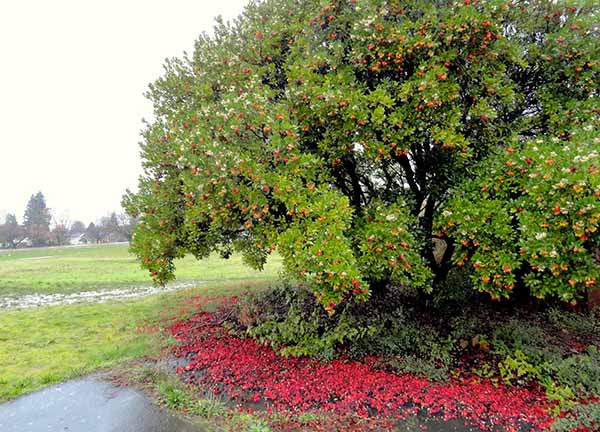

Evergreen shrub-Trachikarpus
Blooms in June, loves sunny areas. The plant is hardy, able to withstand winter frosts in many regions, but requires protection from gusts of icy winds.
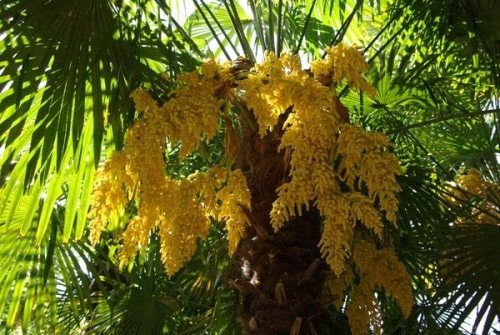

Huge inflorescences are formed in early summer, some specimens grow up to three meters in height, leaves up to one meter wide.
Mahonia holly
Mahonia holly - ornamental evergreen shrub up to 4 m high. This plant grows best in shade or partial shade. Young leaves of Mahonia are orange-green in color, which becomes dark copper in winter.
It tolerates cold well, propagates by seeds.
This shrub blooms very beautifully with small yellow flowers collected in hats. Many sources attribute this species to the genus Barberry called Berberis aquifolium
Holly - evergreen shrub
The symbol of Christmas, it is with it that houses are traditionally decorated on winter holidays. Holly is an evergreen shrub that blooms from October to December, easily tolerates shading, but it is not a shade-loving plant. The greatest color contrast in this plant appears precisely in the sun.
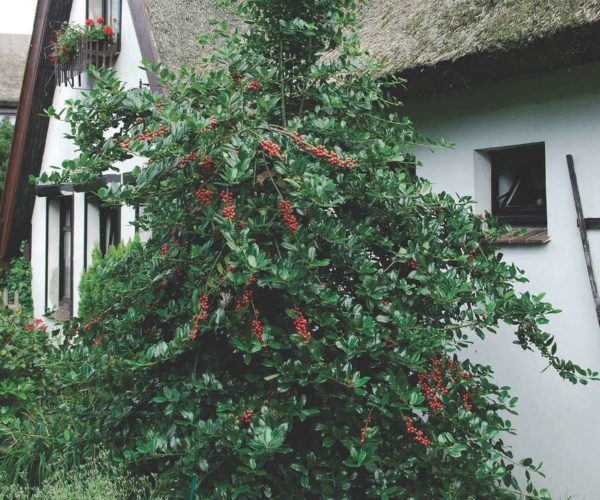

Holly is especially beautiful in winter, when bushes with bright green leaves and beads of red, white, yellow, black and orange berries stand out in the snow, which remain on the bushes all winter.
Iberis evergreen
It is a branchy, low, evergreen shrub with small, dense and narrow green leaves. The plant is very fond of light and blooms with white flowers in the month of May.
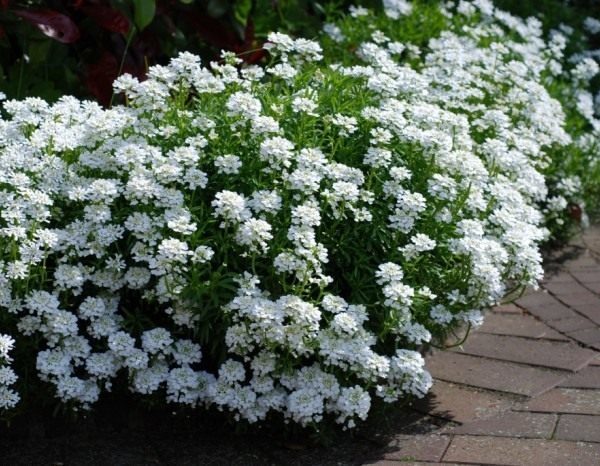

Iberis Photos
Camellia
It is an evergreen shrub with dense, glossy, dark green foliage. It blooms unusually beautifully, forming inflorescences similar to roses.
Camellia Photos
But the value of this evergreen shrub is that its flowering begins ... in the fall and lasts up to three months.
Boxwood - BUXUS
Boxwood withstands wind, alkaline soils and some shading. The stems can be cut regularly. Boxwood is an evergreen shrub that will grow up to 3 m if left uncircumcised.
Boxwood variety "Aureovariegata" has leaves covered with yellow spots; "Suffruticosa" is a dwarf. Propagated by cuttings under glass in summer. Russian names for boxwood - buks, green tree, gevan, bukshpan, shamshit
Choisia
Choisia is a rounded evergreen shrub with a densely leafy crown all year round. Flat inflorescences of waxy flowers appear in spring - both leaves and flowers are fragrant.
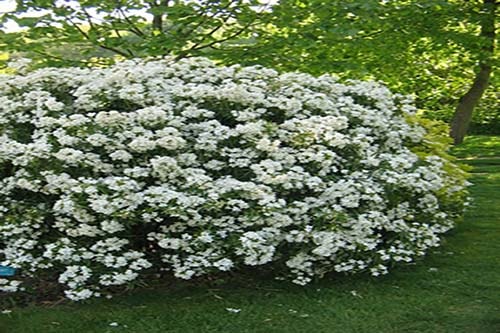

Choisia Photos
Choisia trifoliate - 2 m high. Flowering time: April - May. Location: sunny or slightly shady. Reproduction: cuttings under glass in summer.
Callistemon
Callistemon blooms in the first two summer months. It is recommended to plant in places with good sun light. Propagated by cuttings planted in the summer under a glass canopy.
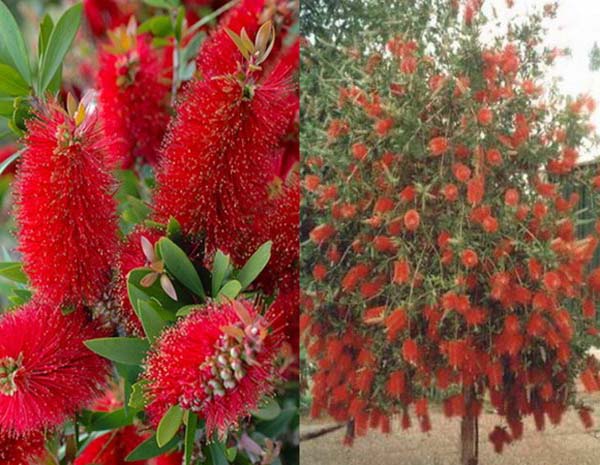

Small flowering, stamens protruding in tightly collected cylindrical inflorescences. Usually planted on the side of the site facing the sun. The bloom is dark pink, the foliage is long. The lemon-yellow callistemon can be up to two meters high, and the hard callistemon is only one and a half meters high, but it is famous for its endurance.
Winter garden with evergreens
In winter, the garden can be green and beautiful with evergreen shrubs and trees that preserve their foliage and color on cold days. On some, fruits are preserved.
Juniper
Ornamental shrubs for summer cottages can be created using juniper. Clustered forms of plants reach a height of up to 3 m, tree-like - from 4 to 12 m. Young seedlings have a reddish-brown bark, in adult plants it becomes brown.
Juniper needles are collected in pairs of several pieces. In addition to its beauty, this evergreen plant has an incredibly pleasant smell and very beautiful green cones. In the second year of growth, the cones acquire a grayish color and look like berries.
There are many varieties of juniper, but the most decorative and popular are:
- "Montana" - creeping shrubs about 20 cm high;
- "Columnaris" - Columnar plants up to 50 cm in height, known for beautiful needles with a bluish tint;
- "Blue Arrow" - Columnar shrubs with blue-gray needles;
- "Mass" - creeping shrubs with gray-green needles.
The plant is planted in open soil in April or October. The best place to plant is a lighted area with loose sandy soil. The shrubs are completely unpretentious in care: only watering is required during drought and periodic loosening of the soil. For better growth, you can feed the plant with nitroammophos in the spring.


Juniper does not need pruning and this procedure should only be carried out if you want to form a hedge from its bushes. In this case, you need to be very careful, since the branches of the plant grow back for a very long time. Propagated by seeds, cuttings and layering.
Did you know? Juniper needles
—
the leader among antibacterials, and the berries of the plant can be used as a seasoning for meat or fish, as they give them a delicious aroma and piquant bitterness.
Summer perennial flowers
Summer varieties are planted to replace spring flowers so that the site will please the eye with flowers throughout the summer season.
Arabis
Arabis will be a good choice for those who do not want to plant a large number of alternating flowers on the site. Arabis spreads on the ground and has a large number of leaves, so it completely covers the ground and does not require the proximity of other flowers.
It begins to bloom in April and blooms until the very frost.
Photo: Instagram landshaft.design
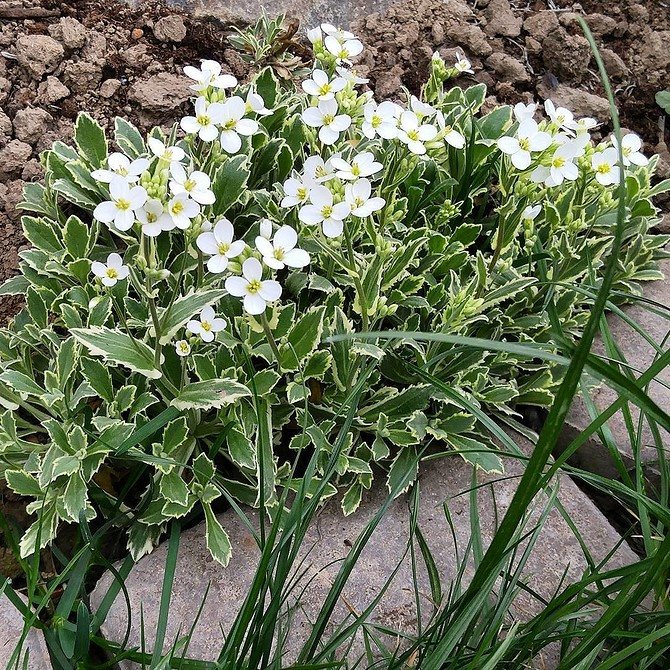

Photo: Instagram multya
Photo: Instagram semena_zakaz
Doronicum
Bright and rich doronicum flowers will be a wonderful decoration for the garden. It should be borne in mind that when they fade, the greens will also fade, so it is worth planting a decorative fern nearby so that the site is not empty.
Doronicum blooms from mid-May to June.
Photo: Instagram nik_ilsen
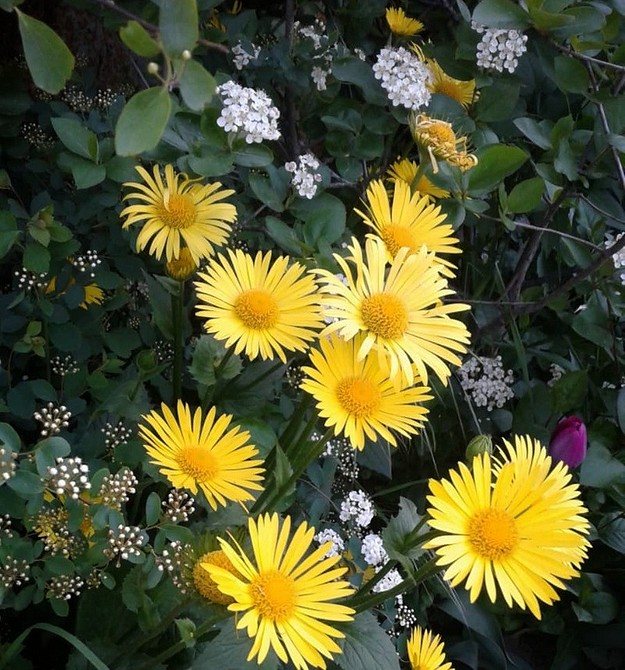

Photo: Instagram tosya_vk
Photo: Instagram ludmilas_gomel
Loosestrife
There are two types of loosestrife: creeping and with high stems ending in large inflorescences. These inflorescences have large flowers of various shades. In addition, the loosestrife is frost-resistant and practically not subject to the threat of pests.
Flowering time is from May to the end of June.
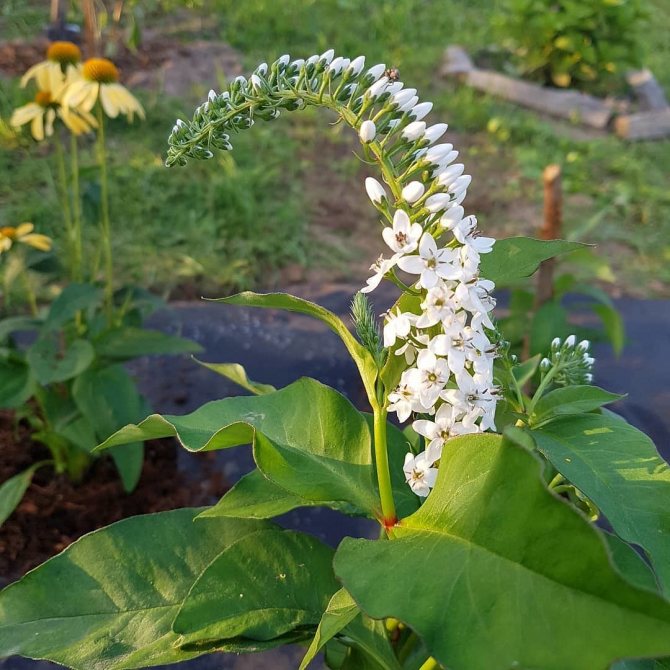

Photo: Instagram art_flora_krsk
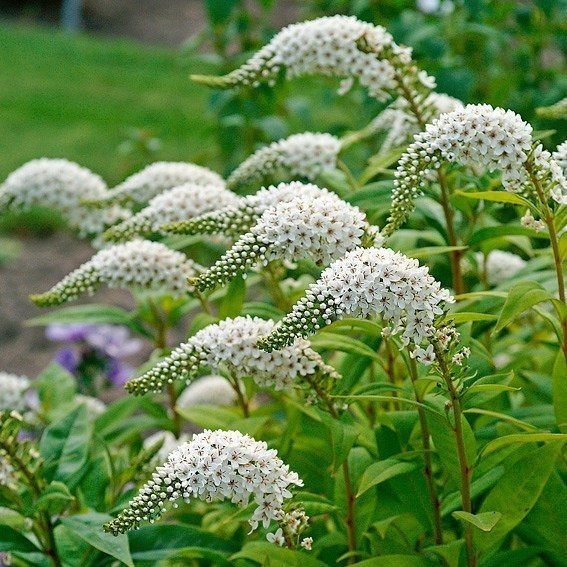

Photo: Instagram best_family_garden
Photo: Instagram sad_yulia
Roses
There are several varieties of summer roses that are especially popular with summer residents.
Golden Elsa
This variety of roses grows to a height of 70 cm and has pale orange flowers. It has a pronounced pleasant aroma and is suitable for hot climates.
It blooms twice for three weeks: in mid-July and mid-August.


Photo: Instagram
Anniversary of the Prince of Monaco
A two-color look of roses, which become snow-white in the shade, and the edges of the petals acquire a crimson hue in the sun. They tolerate rain well and are hardy.
Blooms from May until frost.


Photo: Instagram hozyaistvo_gazeta
Fir


This beauty bewitches the eyes with a slender trunk and a lush crown in the form of a cone. Unlike other conifers, fir for a long period retains the decorative effect of the lower branches. The bark of plants is smooth, grayish, in some species it can crack in old age. The needles are soft, with rounded ends.
A distinctive feature of fir from other coniferous representatives is that its cones grow upward, like cedars, and decay on a tree, and powerful roots go deep into the ground. In total, there are about 50 species and more than 200 varieties of fir.
The most interesting and decorative representatives include:
- Arizona;
- Balsamic;
- Single color;
- Korean fir.
Arizona fir in height it can reach up to 15 m. Its bark is creamy, and ripe cones have a deep red color, needles are bluish-gray. Cultivated plant varieties reach no more than 7-8 m in height and are often used in rock gardens, heather gardens.
Balsam fir grows from 15 to 25 m. The bark is smooth, brown, the needles are dark green in color with thin white stripes, the cones are purple. Today there are 20 types of decorative varieties of this species. A very popular dwarf variety "Nana", which reaches up to half a meter in height (in 10 years) and up to 1 m in width. The needles have a charming emerald hue. Another dwarf variety of fir - "Kiwi", stands out with a beautiful dense, green-blue crown.
Cultural form monochromatic fir in height reaches 8 m. The bark is grayish, smooth, the needles are gray-green, slightly twisted upwards. It has about 30 varieties. The most interesting of these are the Archers Dwarf dwarf variety with a dense blue crown and Wintergold, with yellowish needles in young plants, which change their color to green with age.
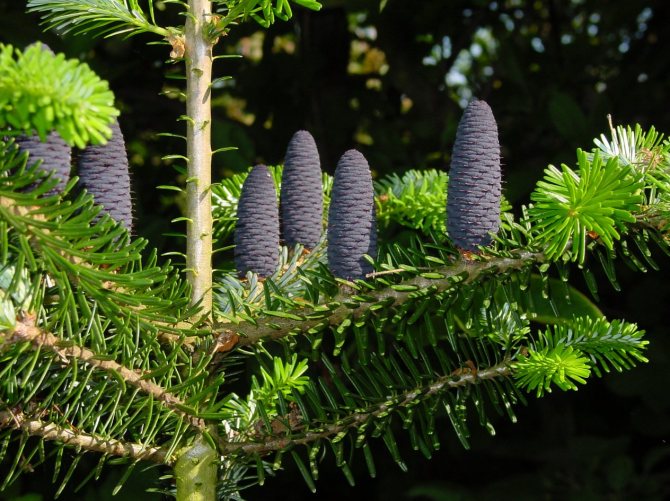

Very beautiful varieties of Korean fir:
- "Blue Magic" - dwarf variety with charming blue needles and lots of blue little cones;
- "Eskimo" - with a gray-blue crown, which looks like a pillow, and thanks to the chaotically located branches, such a fir is also called the "witch's broom";
- "Kula" - grows up to half a meter, has a beautiful pale green crown, which is slightly flattened on top;
- "Molly" - dark green shrub, reaching a height of up to 30 cm.
Fir is best planted in April or September. Young seedlings, after planting, are recommended to be shaded from the sun for some time. Loves lighted places, moist soil. However, it does not tolerate stagnant water. Therefore, the soil must be loose. When planting, do not bury the root too deeply in the ground - its neck should be flush with the soil. The top layer of soil, with which the rhizome is sprinkled, is recommended to be mixed with sawdust and peat for drainage. During periods of drought, the tree needs to be watered.
Important! By the first year of wintering, the plant must be covered with coniferous spruce branches. The young seedling is still weak and may not tolerate large frosts.
Perennial planting features
Unlike annuals, perennials need to be planted in the fall so that they are pleasing to the eye at the beginning of the next season. The plan of the flower bed should be designed in advance. When creating a flower garden, one should take into account not only the compatibility of shades of different plants, having read the photo, but also their flowering time and height. Low views should be in the foreground.
Asian swimsuit (Asian light)
Advice! When planting perennial plants, it is best to focus on tiered planting, since flowers grouped by height look much more spectacular.
Ivy
Ivy refers to liana-like climbing shrubs. It can reach a height of 30 m. Ivy foliage is large, about 25 cm in length, it can have a green, yellow, brownish color. In autumn, the plant blooms with yellow-green umbellate small inflorescences. The next spring, after planting on ivy, black berries form.
Did you know? When rubbed, ivy leaves give off a nutmeg smell. Due to this property, they are used in cooking as a spice or decoration.
Ivy grows for a long time and looks very impressive at the same time.With the help of supports and a garter, you can form beautiful cascades from it, hanging from parkans, fences, balconies, a living evergreen gazebo or even a canopy. The plant tolerates shade well, but develops best in illuminated areas. Loves warmth and fertile soil. Ivy is propagated, most often by cuttings.
There are a large number of decorative forms of ivy, and the most popular are:
- winter - stands out with very large, wide, light green foliage;
- Baltic - the most frost-resistant variety, has small leaves of rich green color;
- treelike - is a small upright shrub with beautiful green leaves with silvery spots;
- tricolor - in autumn, the leaves at the edges acquire a charming bright red color;
- bordered - it is distinguished by the fact that the foliage is framed at the edges with a yellow stripe, which in the fall changes color to red or pink.
Ivy loves moist, loose, slightly acidic soil, but it is especially undemanding to the composition of the soil. It is recommended to mix the top layer of earth with which the root of the plant will be sprinkled with sawdust and peat.
Flowers and herbs
Trees and bushes are great, but few can resist not planting ornamental garden flowers. Especially perennials, which also do not require much trouble in growing seedlings and nursing them when transplanted into the ground.
In addition to them, the site can also be decorated with unusual decorative cereals for the garden, about which many know very little.
How to choose perennials
Colorful and cozy corner
All herbaceous plants are very demanding on the composition of the soil, illumination, and other growing conditions.
When choosing decorative flowers for the garden, first of all, pay attention to this.
- Sun-loving plants should be planted in open areas, most of the day illuminated by sunlight.
- For shade-tolerant flowers, areas on the west or east side of buildings, as well as flower beds located near tall trees that do not cast a thick shadow, are suitable.
- Shade-loving plants, on the other hand, feel better where the sun rarely looks: under the crown of bushes and trees, in the shade of the north side of the house.
Another selection criterion is the height of the plants. For example, tall ones are used for the back or central part of flower beds and beds, for decorating unsightly fences and outbuildings. And creeping (ground cover) - to create tree trunks, create alpine slides and other compositions with stones.
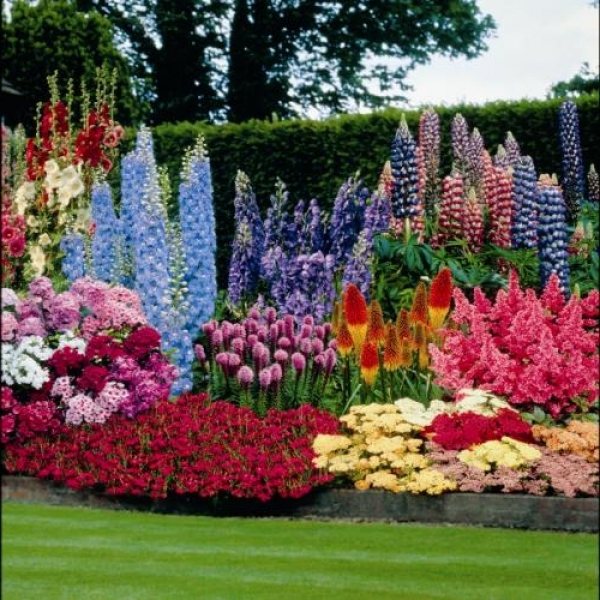

A flower bed of uneven perennials
Especially carefully choose decorative cereals for the garden - not all of them are able to live in a harsh climate, and require complex care. Such herbs include brown and beige sedge, cortaderia, and impera.
But the droplet, turfy pike, feather grass or sesleria are quite unpretentious, and at the same time they can become a decoration of your garden.
Turfy pike
Advice. If you plan to grow flowers and herbs from seeds, choose seeds in simple bags - local breeders' products, adapted to your climatic conditions. The price of a beautiful package with bright colors on it is usually much higher, but the result rarely matches the picture.
Boxwood
Boxwood is an ideal curb evergreen, often used in site landscaping.
Its benefits also include:
- good tolerance to pruning;
- the possibility of good growth in dark areas;
- the ability to form a wide variety of shapes.
The main conditions for the good development of boxwood are timely watering and drained soil. Saplings can be planted from spring to mid-autumn. It is important to keep a distance of at least 40 cm between them. It is recommended to mix the ground for dropping seedlings with sawdust and peat. The best way to propagate boxwood is by bending the shoots to the ground.
Important! The leaves of the plant are poisonous, so in no case should they be eaten. After working with boxwood, be sure to wash your hands.
Boxwood is exactly what you need if you want to shape shapes from evergreens. With the help of a dense crown and a large number of branches, you can make a perfectly flat surface. Complex multilevel shapes are formed using wire frames. The most suitable varieties for this purpose are "Green Gem", "Suffruticosa".
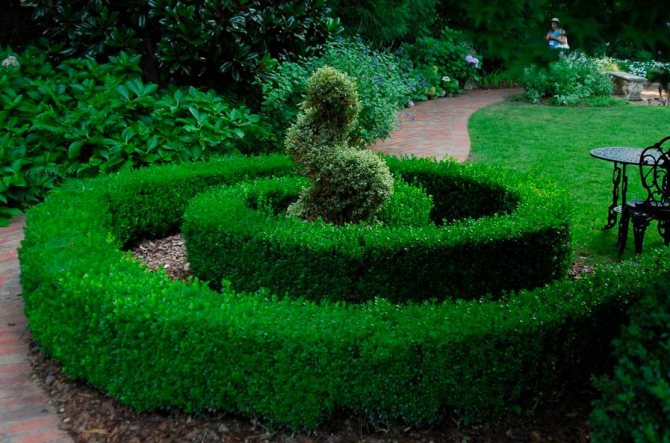

Garlanda boxwood is ideal for making bonsai. For the formation of hedges, such varieties as "Latifolia", "Rotundifolia" are perfect. With their help, you can create any shape - cones, ovals, cubes, rectangles.
Important! Boxwoods often freeze out, but to prevent this from happening, in the fall the soil needs to be mulched with needles, and tall plants should be covered with burlap.
Distinctive features of perennials
Many gardeners prefer to plant annual plants to decorate the garden, motivating this with more lush and vibrant flowering, but they are quite demanding. But there are not only perennial climbing plants, shrubs and herbaceous plants, which is confirmed by numerous photos, and if we take into account all the features when choosing flowers, then throughout the season, from early spring to late autumn, the garden will look blooming. The main features of perennials that distinguish them from annuals are:
- a transplant is needed every 2-3 years;
- frost resistance;
- long flowering period;
- minimal care;
- can serve as the basis for a mixed flower garden, since they grow in one place and can be constantly supplemented by other plants.
Perennial plants will be an excellent basis for future flower arrangements, since they can be separated and planted during transplantation without resorting to additional expenses. For this reason, perennials are much more beneficial than annuals.


Layered arrangement of plants in the garden
A perennial herb with decorative leaves will help, along with flowering ones, make multi-level garden compositions, arrange slides, lawns and flower beds. In addition, there are perennial climbing plants and shrubs that can act as a hedge.
Pine
Pine trees in landscape design are great for single plantings, combining with other evergreen trees (fir, spruce, larch) or alpine hills, and excellent "living" rows are obtained from cedar stalnik pines. For the formation of dense hedges, pines are not suitable, as the needles thin out over time and will not allow creating a dense monolithic wall.
Mountain, cedar and common pines are considered the most suitable for cultivation. Weymouth and Wingir varieties are suitable for regions with light frosts and fertile soils.
The crown is formed by circumcision. It should be carried out in the middle of summer, after the active movement of the sap in the tree ends. Branches can be cut completely or half way. Pruning is not recommended in spring and autumn.
Did you know? If you want more lateral shoots to develop, and the main ones are shorter, pinching should be done in the spring. During it, the buds are cut off at the tops.
The most unpretentious and frost-resistant is mountain pine.
Today there are quite a few of its decorative undersized varieties:
- "Mugus" (a beautiful decorative pine tree, up to 2-3 m high, has a bright green crown with a light green tint);
- "Ophir" (has a dense crown with a yellowish tinge);
- "Varella" (it has a very beautiful long needles of a rich green color, beautiful fluffy balls can be formed from its crown);
- "Winter Gold" (it is distinguished by sharp needles of yellow-green color).
Pines love light and are very vulnerable to aphids, bark beetles and worms. Therefore, if such enemies are identified, the plant should be immediately treated with appropriate insecticides.In addition, these evergreens do not tolerate fungal diseases well. To increase the resistance of plants to fungal diseases, it is recommended to feed them with complex mineral fertilizers.
TOP-10 unpretentious long-flowering perennials with photos
When choosing perennials, one should focus on the maximum possible size of an already adult plant. Groups of such crops are formed by size and flowering time. In this case, it is necessary to take into account moisture, soil and light preferences. If watering can be difficult, it is recommended to choose drought-resistant specimens.
Aquilegia (catchment, orlik)
They grow in the front or middle of the flower row. They can reach 80 centimeters in height and spread up to 50 centimeters in diameter. They differ from their wild relatives by the number of petals on the flowers. Extremely hardy and resistant to all summer weather. The flowering period usually begins in June - July and, with proper plant care, continues until late autumn.
Seeds should be sown in moist compost in autumn or late spring. It can take three months for the seeds to germinate - during this time, keep a plastic-covered pot on a greenhouse shelf or window sill in your home away from direct sunlight.
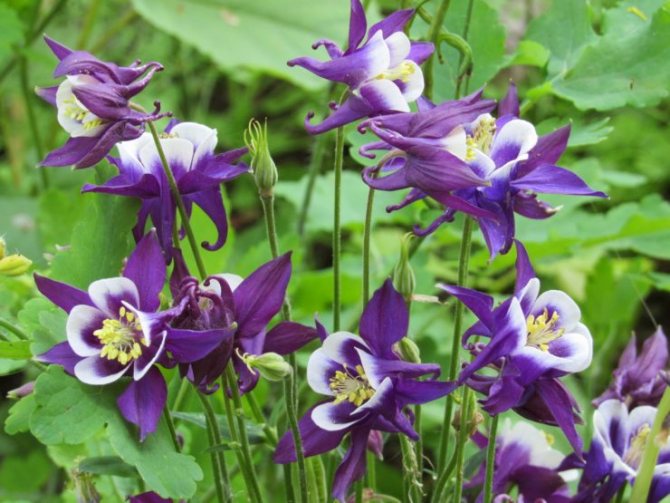

Gardeners love aquilegia for unusual flowers and delicate foliage.
Alissum
Unpretentious perennial shrub-type flower with a pleasant, special smell. Alyssum's typical colors are white, lilac, pink, yellow, purple and blue. Resistant to drought and heat, but grows best in partial shade. It blooms from spring to autumn.
To grow alissum, it is necessary to sow the seeds directly into the soil in warm spring or autumn. Another option is to grow seeds in a greenhouse or pots at home during the spring, and then plant flowers at a distance of 15 centimeters from each other.
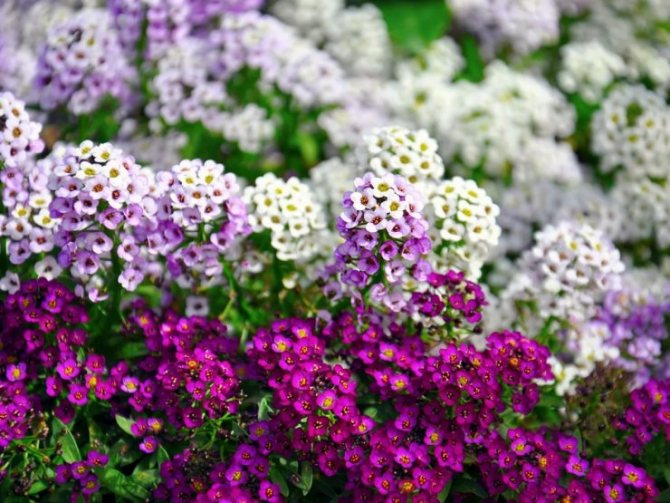

An alpine slide or border is well decorated with alyssum
Ayuga (tenacious)
An extremely unpretentious undersized plant that can survive on any soil and with any watering. In late spring, it blooms with blue, white and pink flowers, collected in a long inflorescence. It does not fade for a long time and remains bright throughout the summer season.
Sowing seeds in open ground should be done in the spring, when the earth warms up enough, or in the fall - when it has not yet had time to cool down.


Groundcover Ayuga grows into a colorful carpet
Verbena
Unlike many other perennial plants, verbena is not so hardy, so to overwinter it must be covered with protective mulch. Easily spreads to the areas adjacent to the planting area. It has an attractive aroma and is in great demand among butterflies.
You can grow verbena from seeds. To do this, you need to plant them in pairs in pots at the end of winter or early spring. Leave containers in a bright, but not sunny window. After the sprouts have reached sufficient size, each plant should be placed in the ground in an open area at a distance of 25-30 centimeters from each other. With proper care, verbena can bloom until frost.
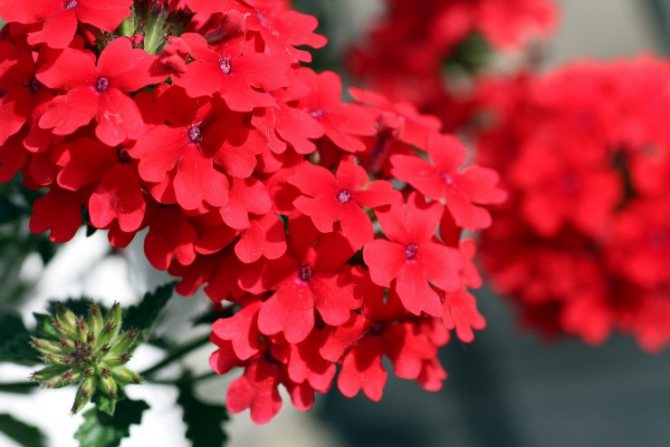

Active watering is contraindicated in verbena
Spike veronica
A distinctive feature of this plant is a tower of blue star-shaped flowers and a low height - only about 30 centimeters. Grows well in containers, blooms for a long time (June to August).
In order to grow spiked Veronica in your garden, you need to choose a sunny spot with well-drained soil and place the seeds directly in the soil. It is recommended to do this in the second half of autumn, when the frost has not yet come and the soil has not become too cold. It is possible to plant seeds for seedlings in early spring, but in this case hardening of the seed material is necessary. And in fact, and in another case, the plants will bloom only in the second year of life.
Veronica spicata is used in folk medicine and to decorate flower beds
Carnation
Due to its low height (only 10-15 centimeters), it is recommended to place a carnation along the front edge of the flower garden. To grow carnations, the seeds should be planted in trays in the fall and placed in a cold place. Upon the arrival of spring, transplant them to their final position in a sunny area. It is allowed to grow seeds in pots on a sunny window or in a greenhouse, followed by transplanting sprouts into open ground. The seedlings must be sufficiently developed for this.
The flowering period begins in early summer and lasts until the first cold weather.
Carnation is grown as an ornamental plant for the garden and for cutting
Iris (iris)
An amazing perennial with many varieties. Some varieties prefer moisture and are able to grow directly in water, and some do not require watering even on the hottest summer day. Flowers appear if the plant is in direct sunlight or in partial shade, they last for a long time. The time of their appearance depends on the specific type and variety of the flower (dwarf irises tend to bloom in spring, and tall ones - in summer).
You can plant irises in open ground in both spring and autumn.
Even evergreen varieties of iris are found in nature.
Knifofia (kniphofia)
A flower with fiery spiers capable of growing up to 90 centimeters in height. It is recommended to place it in the middle of the flower garden. Blooms throughout the summer, tends to grow. He loves moisture, however, like most plants, he does not tolerate stagnant water in the roots.
Sowing seeds is recommended in March and early April.


Knifophia needs good drainage
Day-lily
An unpretentious flower plant that prefers sunny places. Blooms in summer for several weeks. The life of a flower is one day, but there are quite a few of them on long peduncles. If you remove wilted peduncles in time and feed the plant, then the daylily will constantly throw out new arrows. In remontant varieties, flowers appear until the onset of frost.
The daylily planting time is one of its advantages, because it covers the period from early spring to late autumn. If the cold period begins early in the region, then it is recommended to plant this flower at least a month before the onset of frost.
Mass flowering of daylily is observed in a well-lit area
Pion
Old varieties of this plant are extremely unpretentious, but among new cultivars, many require close attention. Peony blooms, as a rule, in late spring. Able to grow both in the sun and in partial shade. If at least a couple of hours a day direct sunlight will fall on the plant, then it will bloom beautifully in the shade. The more darkened the peony grows, the longer the period of its flowering lasts.
The optimal time for planting peonies in open ground is late summer-early autumn, but if necessary, they can be planted in spring.
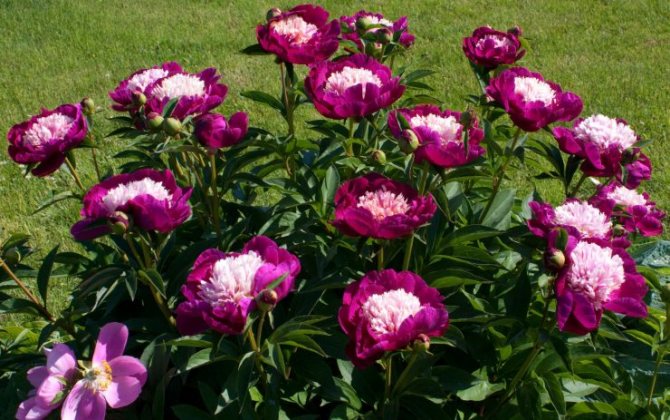

Peonies can be both herbaceous and shrub forms.
Yew
A distinctive feature of these evergreens is the flat, dark green needles and red small cones that look like berries. It grows for a long time, but it can easily live up to 3 thousand years.
Perfectly tolerates shade, does not like gassed air. Grows well on loose soils, tolerates drought well.
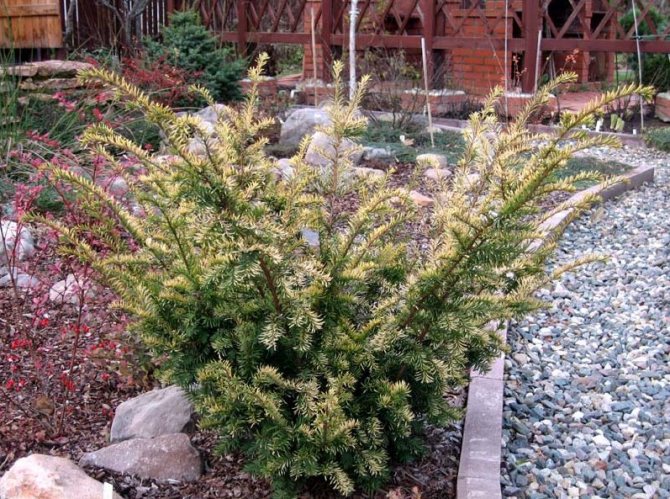

Important! Cones, needles and bark of yews contain toxic substances. In no case should they be eaten. After planting, caring for the tree, touching it, be sure to wash your hands well. It is recommended to exclude contact with the plant of children and pets.
Eight types of yew are known. The most popular is berry yew, and today a large number of its undersized decorative varieties have been bred:
- "Elegantisima" - perfect for the formation of hedges and group plantings, a ten-year-old plant reaches a height of one and a half meters, young plants are interesting with white-golden needles, which change with age to green with a yellow border;
- "Semperia" - a frost-resistant variety with bright golden needles, at the age of 10 it grows up to only 50 cm;
- "Horizontal" - the crown of this yew grows very broadly, and reaches a height of only 1 meter, the needles are light green;
- "Washington" - has a beautiful curved green needles with a golden border.
Yew tolerates cutting and pruning well, therefore it is suitable for the formation of a decorative crown.
Stunted perennials
Flowers with a stem height of up to 30 cm will effectively complement a flower bed or form a solid bedspread on a hillock. These include pansies, gentian, geranium, cinquefoil, sage, dwarf carnation.
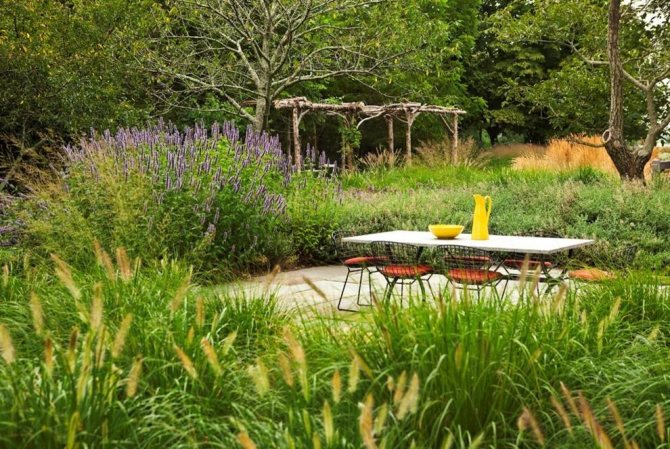

Blue sage bloom
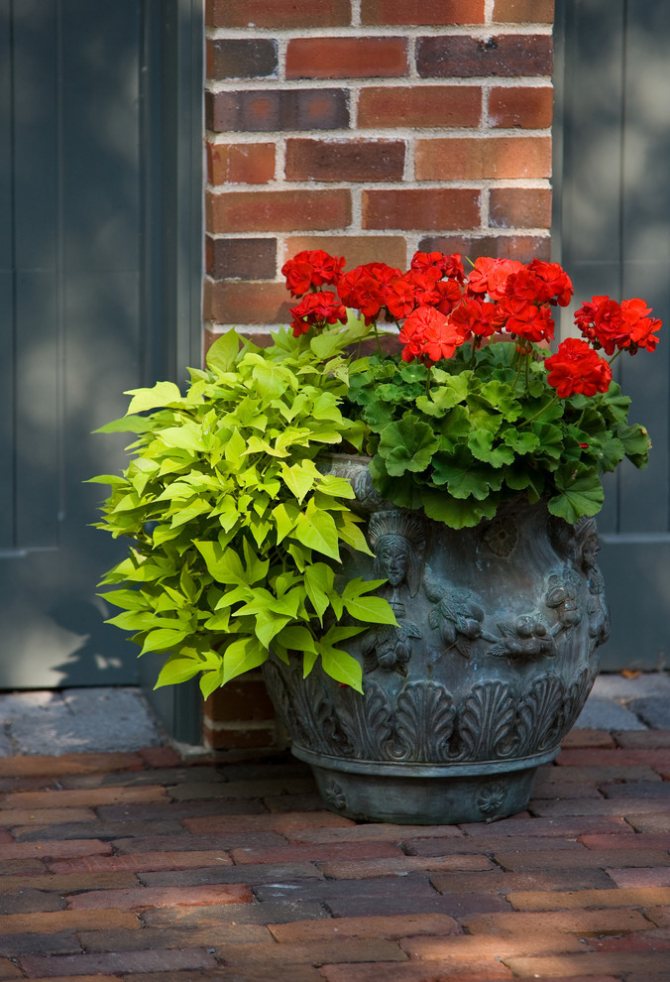

Geranium: lately it has been in great demand in landscape design. Able to form dense thickets
Bright undersized flowers - blue periwinkle, yellow or pink Amur adonis - feel great in the shade.
Periwinkle - creeping dwarf shrub
Branduka in landscape design
This plant works well with other early flowering spring crops. The best neighbors for him will be daffodils, woodlands, lungwort.
Such flower beds create a spring mood in the garden, filling it with bright colors. The bulbodium is also suitable for decorating rocky hills and curbs. Sometimes it is located next to artificial reservoirs.
Among the primroses, there are many plants that, after winter days, delight with their gentle flowering, therefore the first messengers of spring in the garden or in the country are especially pleasing to the eye, missing bright colors and living greenery. For the sake of a few days of flowering, people also grow a brandy. Its name is three times - bulbokodium, but it is used less often.
This flower is very similar to the crocus, sometimes it is compared to a daffodil or crocus, because it looks like them outwardly. In addition, these primroses are also grown from bulbs and are related. The principles of planting and caring for a brandy in open ground do not pose a problem, therefore, for people who decide to bring the saturation of spring colors to their site, the bulbodium is ideal.
Planting material
In order to get a brandy in the garden, seed and vegetative propagation is used. Vegetative is simpler and faster, therefore, the seed method is resorted to in cases where it is necessary to grow a large number of specimens.
Seeds
It is not often possible to find bulbocodium seeds on sale, so you need to contact large suppliers or order them in online seed stores. It is important to pay attention to the packaging time, since after the second year the germination rate drops sharply.
Before planting, seeds need to undergo three stages of stratification:
- Stage 1 - holding at a temperature of 3-7 ° C;
- Stage 2 - the content in the heat is about 18 ° C;
- Stage 3 - re-placement at a temperature of 3-7 ° C.
Each stage lasts three months. Throughout all periods, care must be taken to keep the humidity low.
After that, the seeds are sown in pots or planting boxes. You do not need to cover them, since greenhouse conditions are not needed for the germination of the bulbocodium. Before the appearance of the first seedlings, the planting is kept in cool conditions at 5-7 ° C, but after the appearance of the first leaf, they can be moved to normal room conditions.
Sowing directly into open ground is also used. This is done in the second half of September and early October. With this type of planting, stratification is not carried out, a natural cold period is sufficient. Seedlings appear in the spring of next year.
With the seed type of reproduction, the first flowering occurs only 6-7 years after sowing, since for the formation of buds, the brandy needs to increase a sufficient bulb mass.
Bulbs
To purchase bulbs, you can use two methods: purchase them in the store or take them from people who grow the bulbodium and can share the babies that grow around the mother's corm annually.
Bulbs appear in the flower shop for sale in autumn and winter. The best option is an autumn planting in order to observe flowering already with the first warming. When choosing planting material, you need to remember that the larger the bulb is in diameter, the more numerous will be the formation of buds.
If the babies are taken from the mother's bulb, then you should not wait for flowering in the first year after planting: it will take a couple of years to accumulate a sufficient amount of nutrients.
Plants are often purchased for distillation that bloom by a certain date. Such specimens must be allowed to completely bloom and go into a state of dormancy. When there are no green parts left on the surface, the dried bud and leaves are cut off and with the onset of heat and transplanted into open ground. Then they are looked after in the same way as for adult specimens.
Photo of undersized flowers
The basic principles of creating flower beds of continuous flowering
In order for the flowerbed where annual flowers blooming all summer to be planted to be beautiful, it is necessary to take into account some nuances:
- You need to choose a place to create such "beauty". The site must have a wide area. At the same time, it is important to determine its boundaries, find out what characteristics the soil has on it. And only then should you decide on the plants that will be comfortable there.
- In order not to scatter eyes in a garden store, where they sell the seeds of annual flowers that bloom all summer, you need to decide in advance on their number and types. For a beginner, only 2-3 types of flowers will be enough, which will be unpretentious in care. Specialists and craftsmen can identify up to 5-6 species of annuals, having thought over their combination in advance. Not sure which annual flowers to choose for your summer cottage? Photos with names will help you understand the varieties. They are easy to find on the Internet.
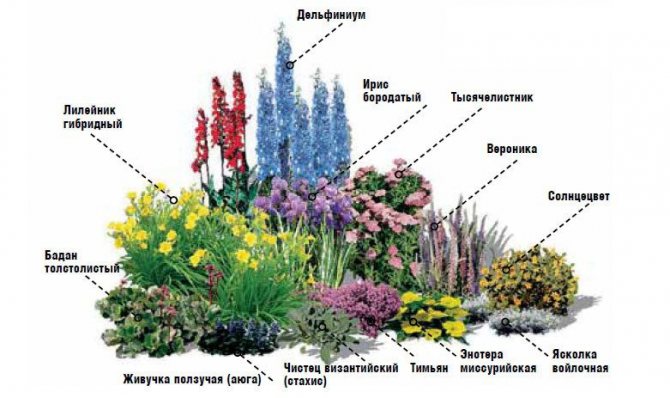

- In one flower garden, the seeds of annual flowers should be planted, which bloom all summer and require the same care.
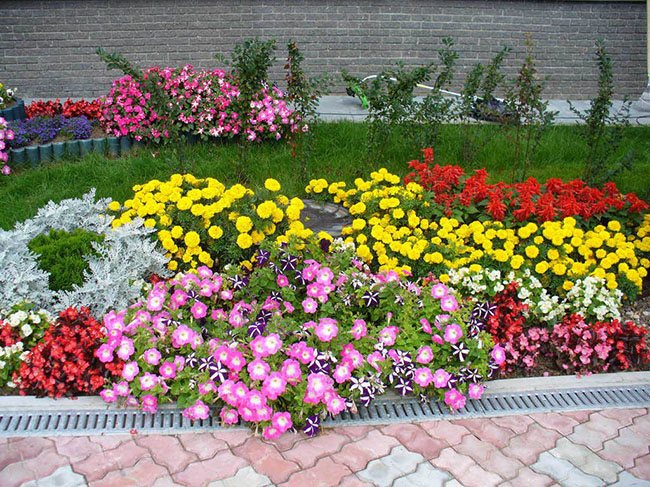

- It is advisable to avoid mixing different species and types of plants. Otherwise, you get a messy flower bed.
A flower bed with dahlias: 1 - bright yellow dahlia, 2 - blue hybrid delphinium, 3 - monarda, 4 - ordinary Dubrovnik
- Responsibly, you should select the colors and shades of annual buds. Strong brightness and variegation are inappropriate. Such a flower garden will tell about the bad taste of the gardener.
- When composing the desired annual flowers for a summer residence, blooming constantly, you need to take into account that they should look beautiful from all sides. You should not be guided by only one viewing angle.
- A decent result will be obtained if you plan the flower bed in advance. To do this, you can simply draw a diagram of the flower garden using colored pencils. So it will become clear which plants and how much it costs to buy. You can depict several options, and then choose the one that you like the most.
- Have you chosen annual flowers for the garden (unpretentious, long-blooming, beautiful)? If so, then all that remains is to fulfill your dream of creating a luxurious flower bed that will delight everyone with its flowering throughout the garden season.
What to consider when growing perennials
When choosing the type of perennial flowers, it is important to take into account not only the appearance of an adult plant, but also the peculiarities of placement. Some varieties thrive best on a sunny alpine slide, while for others, light can be extremely dangerous. For more examples of unpretentious garden perennials, see here.
There are several criteria to consider when choosing colors:
- Lighting features.Different plant varieties require different amounts of light to grow and develop. There are light-loving (all bulbous, lily, some varieties of rudbeckia), shade-tolerant (primroses and aquilegia) and shade-loving (home lilies of the valley, rogers and garden oxalis) perennials. This issue must be clarified even at the stage of acquiring seeds, since choosing the wrong place can lead to weak growth and even wilting of flowers;
- Soil composition. All perennial plants require different amounts of minerals for harmonious development. For example, irises and poppies can be planted even in an infertile place, for lupins and asters, medium-fertile soils are required, and some whimsical varieties can only grow in highly fertile lands (peonies, dahlias);
- Features of the structure of flowers. The choice of a place for growing flowers must correspond to the external characteristics. For example, you should not plant ground cover varieties in hanging pots, but place tall plants on alpine slides. It should be borne in mind that some plants grow strongly as they develop, so you need to provide sufficient space in terms of area;
- Humidity level. For some flowers, water is an important source of development, while for other species it can lead to the development of serious diseases. The perennial variety must be selected depending on the relative humidity. Allocate moisture-loving and dry-loving varieties, as well as representatives of moderately moist soils.
Carefully read the annotation on the seed package. It is there that you can find all the detailed information about the requirements for growing two-year-olds and creating a beautiful perennial garden, since different varieties and hybrids of the same species may differ in their characteristics. Proper planting and caring for primrose and other flowers is a guarantee of a blooming flower bed.
Perennial primroses
These plants delight with their brightness, tenderness and grace at a time when there is snow. Most of them prefer moist soil and shade.


To achieve the desired effect, spring primroses are placed in mixed beds, between tall shrubs and on an alpine slide. The list of the most demanded includes:
Anemone
Corollas bloom in late April and early May. This period lasts for 2-3 weeks. Luscious foliage is combined with vibrant flowers.
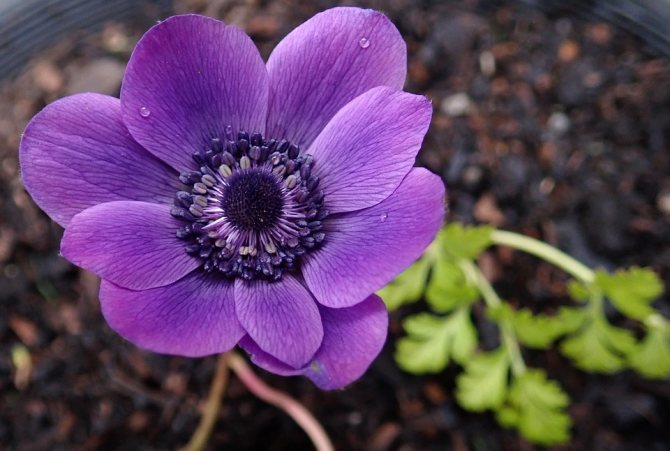

The latter can be white, yellow, blue, pink, red and purple. Withered anemones have an unsightly appearance. Next to them, it is recommended to plant plants that bloom in summer and autumn. Reproduction takes place with the help of seeds and dividing the bush. The separated parts quickly take root. The diameter of flowers is from 65 to 80 mm.
Snowdrop or Galanthus
An unpretentious plant that needs shade, moisture and coolness. The duration of flowering of early bulbous plants depends on weather conditions.


The snowdrop has a pleasant aroma, neat white drooping bell-shaped corollas, and the ability to grow quickly.
Tulip
In the spring, flowers bloom, belonging to simple and double early varieties. In a flower garden, tulips are often combined with evergreen perennials. They usually do not exceed 40 cm.
Also read about when to plant tulips.
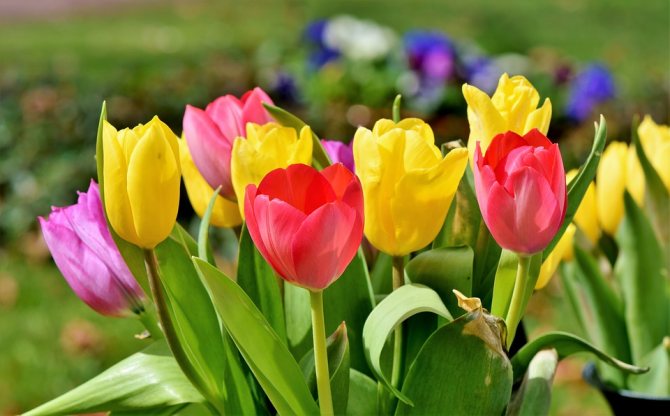

Daffodils
Height from 5 to 50 cm. Corollas are yellow and white. The daffodil can be planted in a shaded or sunny area. Reproduction is carried out using bulbs.


Crocus
They bloom at the same time as snowdrops. The buds are creamy, yellow, blue and purple. Flowering begins in March. Read about planting crocuses in a separate article.


Grouse
Flowers of drooping form. Grouse bulbs are not protected from external damage. To prevent their appearance, it is recommended to use a solution of potassium permanganate.
Forget-me-not
Loves moist soil and shaded areas. Delicate blue inflorescences, bright leaf blades in the form of a heart.
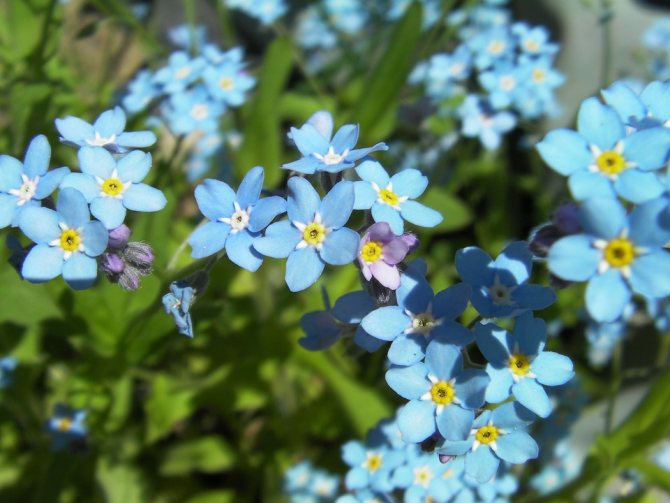

Lungwort
A short perennial that prefers partial shade.Dark green leaves are decorated with specks and dots. Blue and pink corollas are located on the same stem.
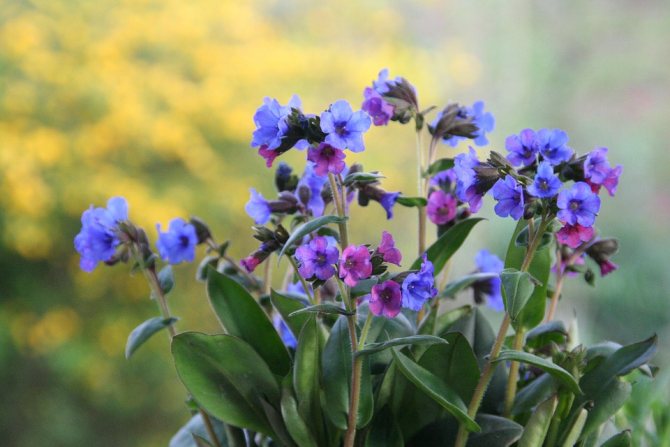

Dicenter
Heart-shaped light purple, white and pinkish flowers, arched stem. The height of the bush reaches 100 cm. The corolla of the dicenter bloom in May. Propagated by dividing the rhizome.
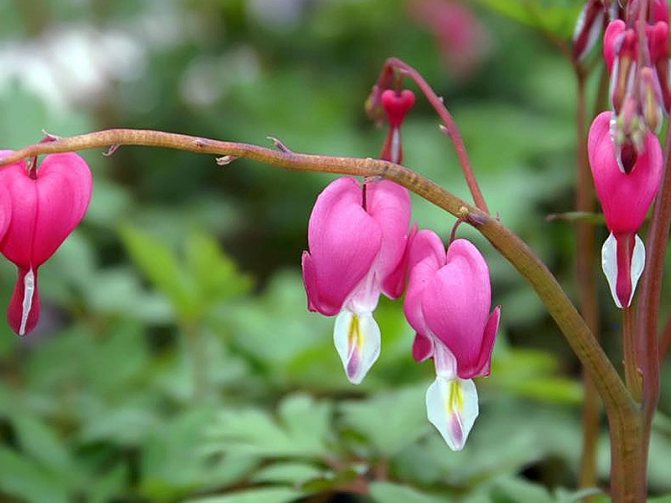

Muscari
Delicate blue inflorescences outwardly resemble a bunch of grapes. The plant can be planted anywhere in the garden. Among the characteristic features are light-requiring and winter hardiness. Blooms in April-May. Coloring can be one-tone or two-tone. Muscari-chameleons are distinguished into a special category.
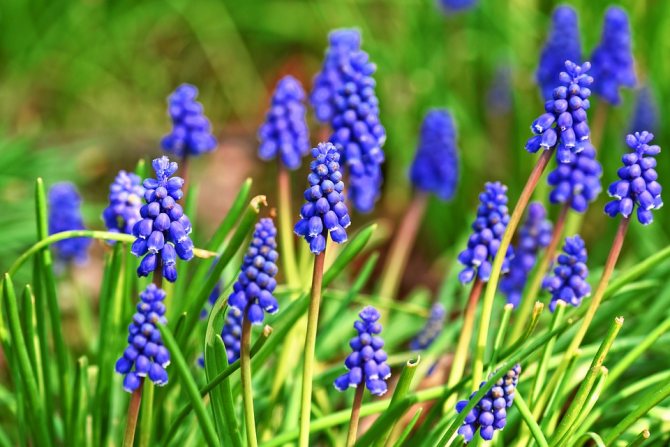

Primroses
They prefer shade and loose fertilized soil. Primrose colors can be varied. Corollas are cushion, capitate, umbellate, bell-shaped, tier-shaped.
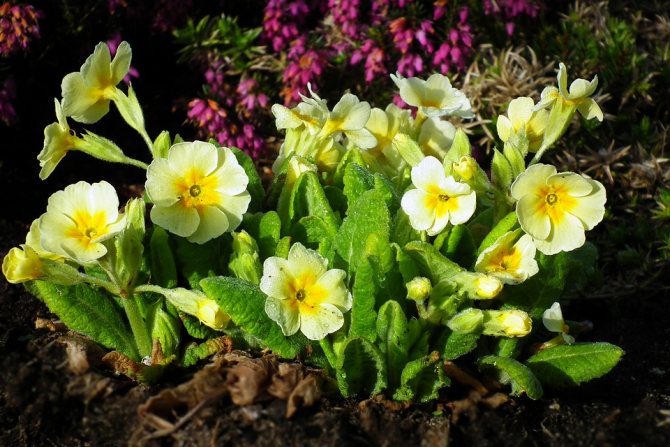

Hyacinths
Blue buds appear at the end of April. The plant needs cool, fertile and drainage soil. With excessive moisture, hyacinth bulbs die. Planting is carried out in early autumn.
Proleska or Scylla
Short and hardy, they create a bluish carpet effect. Propagated by bulbs, self-seeding is possible. Woodpeckers quickly adapt to changing climatic conditions. The complex of fertilizers includes nitrogen, phosphorus and potassium.


Lily of the valley
Delicate and graceful flowers resembling bells. The plant loves moist soil and partial shade, is afraid of drafts. Lily of the valley transplant will have to be abandoned.


Periwinkle
Creeping plant, flowering period begins in April. Corollas come in different shades of blue. Unpretentious to the ground, needs partial shade. Periwinkle grows rather quickly.
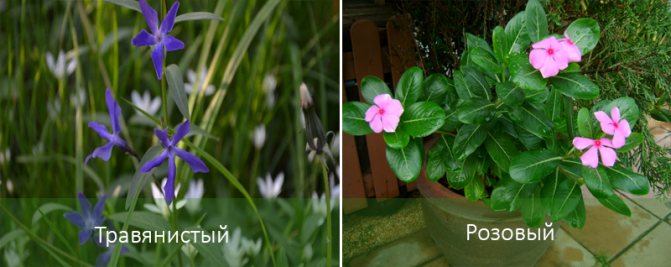

Benefits of perennials
Perennials have a number of advantages when compared to annuals:
- do not require annual purchase of seeds, seedlings;
- do not need annual planting in the ground;
- prone to overgrowth;
- resistant to various weather conditions.
Plants that can resume their growth cycle on their own are less susceptible to disease and more resilient. Many specimens do not require special conditions for their development and reproduce easily.
Blooming perennials can become the basis of the entire decorative composition in your flower garden in the country. It can be supplemented with any annual flowers, tall and short, which can be easily replaced every year with new species, thereby changing the appearance of the flower beds.
The advantages of perennials
Florists often prefer to plant perennial rather than annual ornamental crops, creating flower arrangements for a long time. The advantages of perennials include:
- no need to renew plantings every spring;
- tolerance of flowers to frost and winter conditions;
- use as a basis for a group flower garden;
- less time and effort spent on caring for the plant;
- the ability to propagate the plant vegetatively, which makes it cheaper to grow.


Photo: <>
Distinguished by decorativeness, perennials are also easy to care for.
Flower bed formation technology
The creation of the shape and type of flower garden depends on many factors. One of the most important things to consider is the height and appearance of the flowers. Flower beds are the simplest and most versatile form. There are three common types of such a landing:
The creation of a general scheme of the flower bed allows you to choose the right place for planting plants, taking into account the optimal neighborhood and growing conditions.
- for undersized flowers. To create it, you need to choose plants whose height does not exceed 30 cm. By using various varieties, you can form real living drawings from flowers. In this case, it is important to take into account the shade of the petals, as well as choose varieties that have a similar flowering period. The size of a low-growing flower bed depends entirely on the planned planting area;
- for medium colors. Plants with a height of 30 to 80 cm can be placed on it. Using this type of planting, you can decorate the landscape with a tiered composition or a classic single-species planting.A flower garden of this type can be different in size;
- planting tall plants. For this purpose, you need to choose varieties with a height of over 80 cm. A flower bed for tall flowers can be in the form of an island planting or as a hedge. Some gardeners plant tall perennials next to buildings, which allows not only to decorate the exterior of the building, but also to hide the imperfections of the wall. For more information on the technology of forming a garden flower bed, see here.
A single planting of perennial flowers is also permissible, which allows you to decorate the local area without compromising the harvest of agricultural crops. In this case, it is recommended to choose varieties that have the shape of a lush bush, and creeping or low-growing perennials are worst suited for single planting, with the exception of small flower arrangements.
The purpose of perennial low plants
Low-growing perennials help gardeners solve many problems. After all, these flowers:
- do not require constant and complex care;
- no need to water regularly and abundantly;
- they only need one or two dressings per season;
- easy to sit down, move to another place and share;
- grow quickly and begin to bloom already in the first or second year after planting;
- can bloom all season;
- go well with other types and varieties of plants, as well as trees and even garden crops;
- take root on different soils, there are varieties of perennial flowers for sandy or rocky soil.
Important! The main advantage of undersized perennials is that they do not have to be planted every spring. It is enough to do it once, and then enjoy the beauty of the created composition for several years.
Types of brandy with photos and descriptions
Brandy multicolored Bulbocodium versicolor description
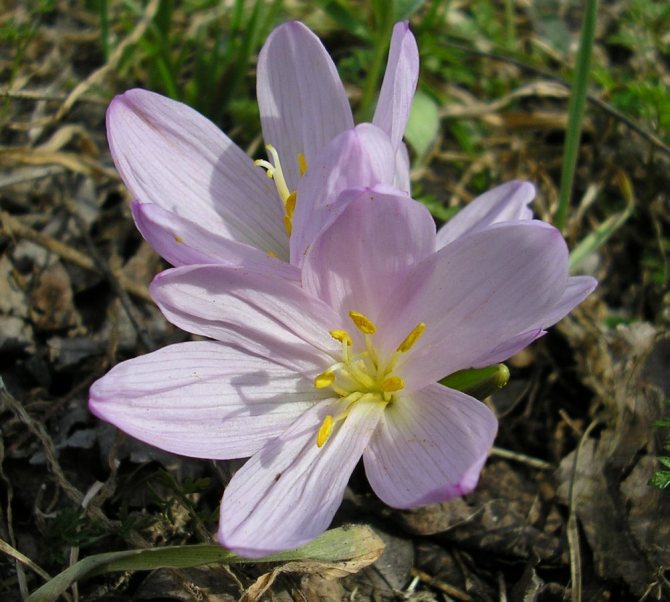

Brandy multicolored Bulbocodium versicolor photo herbaceous plants for open ground
It grows with the beginning of spring in the open areas of the forest-steppes of Ukraine, the Mediterranean. The appearance is similar to saffron. Large, pink-lilac flowers up to 7 cm in diameter are located almost on the soil surface. A delicate, sweetish aroma of flowering soars near the Brandushek curtains.
Brandy spring Bulbocodium vernus description
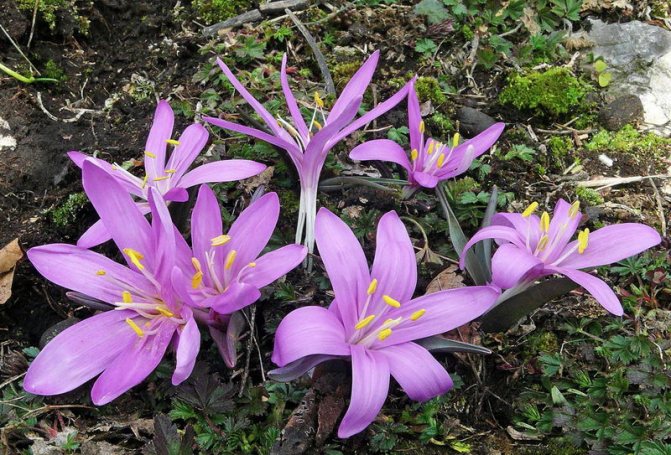

Spring brandy Bulbocodium vernus photo
Originally from the meadows of Moldova, Belgorod region and Crimea. Listed in the Red Book of Russia and Ukraine. An early flowering ephemeroid with lilac-pink star-shaped flowers, which are slightly larger than that of Brandushka multicolored.
They prefer sunlight or weak partial shade. They feel comfortable near tree trunks. Used successfully for forcing.
Wintergreen favorites with beautiful flowers or variegated leaves
The most beautiful and darker shades of green are usually found in evergreens. But only luxurious greens are not at all limited to colors, and in spring or summer one wants so much that luxurious crowns also join the general parade of flowering. The problem with dull green will be solved by beautifully flowering species that hide for several weeks under a lush veil of inflorescences, as if they explode with bright flashes.
The most famous beautifully flowering evergreen shrub is the rhododendron. It is the most striking, lush and elite garden shrub that prefers shading and predominantly acidic, nutritious soils. The only exceptions are rhododendrons of the Inkarho group (inkarho-rhododendrons), which tolerate alkali well. Today, hardy hybrids are especially appreciated, and the choice is made not by species, but by varieties, the assortment of which covers the most varied shades and sizes.


Mahonia bealei. <>
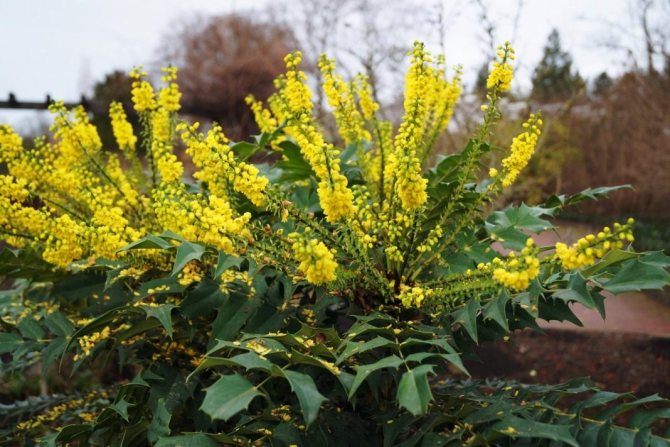

Mahonia medium (Mahonia media).
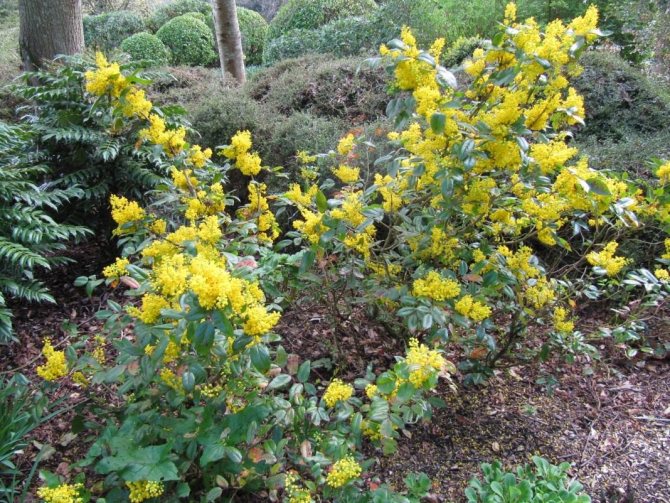

Holly barberry (Berberis aquifolium), or Mahonia aquifolium.
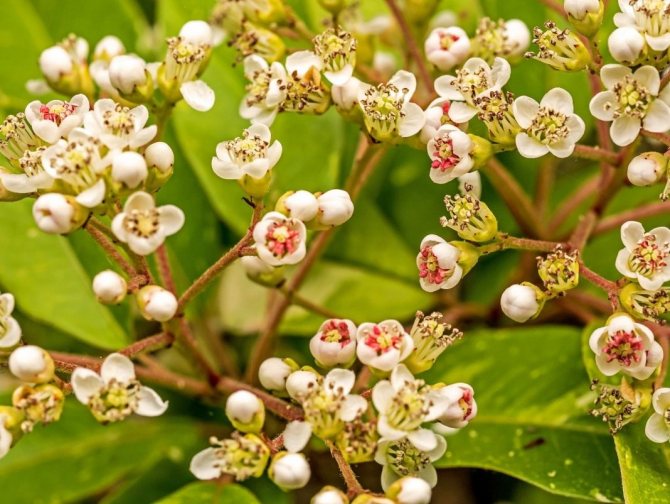

Photinia davidiana. <>
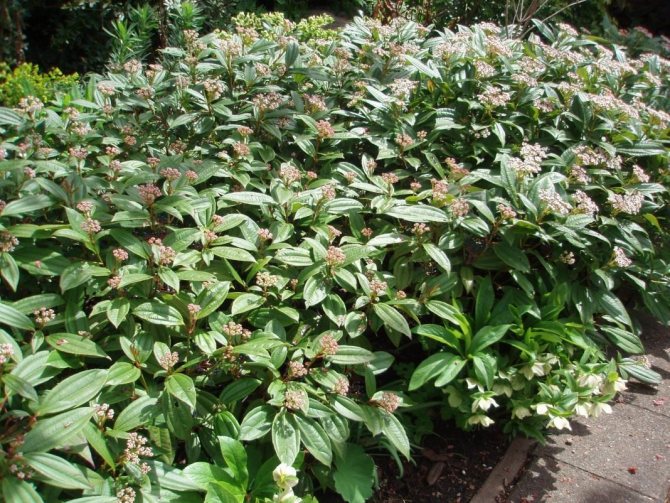

Kalina David (Viburnum davidii). <>
But the range of evergreens from the flowering group is not limited only to the most eminent shrubs.Also noteworthy:
- beautiful evergreen Kalina David (Viburnum davidii) is one of the best ornamental varieties of this classic shrub;
- Broadleaf Kalmia (Kalmia latifolia), known by the nickname of the mountain laurel, which produces numerous wide bells with a touching color in June;
- Japanese skimmia (Skimmia japonica), valued not only for the spectacular umbrellas of inflorescences, but also for the beauty of red berries and in regions with harsh winters, combining garden and indoor "career";
- Spiky gault or pointed (Gaultheria mucronata, sometimes distributed here under the old name Pernettya mucronata) is one of the most spectacular ornamental berry plants;
- hybrid Photinia Frazera (Photinia fraseri) with its small, white, panicle flowers, formerly known as Stranvesia (Stranvaesia) Photinia David (Photinia davidiana);
- blooming in spring with yellow flares Magonia (for example, Mahonia holly (Mahonia aquifolium), which is more correctly called Holly barberry (Berberis aquifolium), hybrid Mahonia medium (Mahonia media), Magonia Bila (Mahonia bealei), etc.
Gaultheria mucronata.
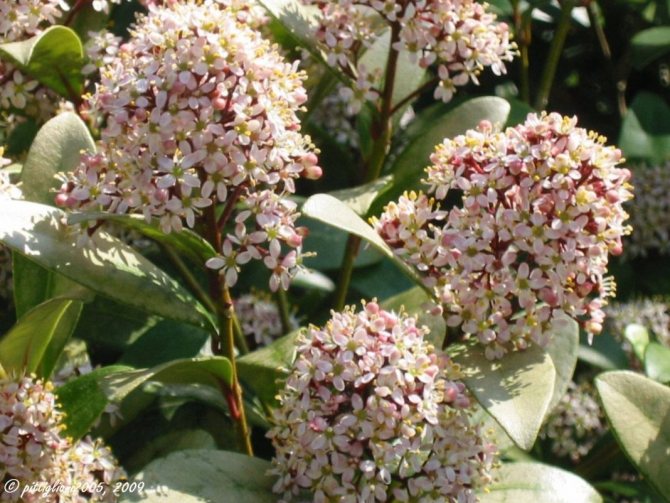

Japanese skimmia (Skimmia japonica). <>
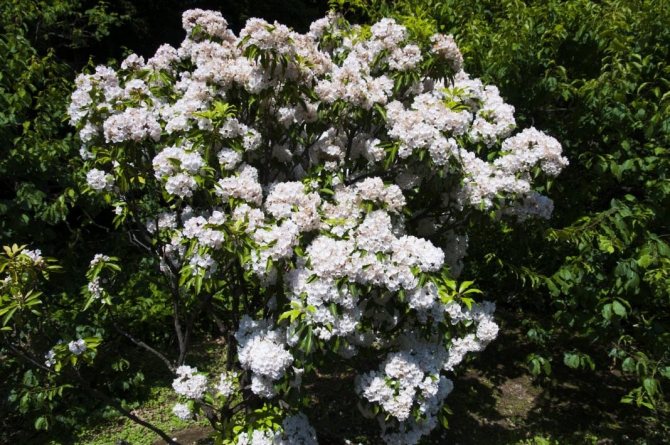

Broad-leaved Kalmia (Kalmia latifolia). <>
If flowering shrubs require more maintenance, variegated plants give the same effect of an explosion of colors, without making the seasonal work schedule difficult. Almost any coniferous species has its own variegated varieties - from spruce to juniper, and other winter-green plants. For example, the variegated variety "Maculata" Loja prickly (Elaeagnus pungens) gives the whole bush an amazing elegance, curly, lacy crown seems unusual and as if glowing from the inside.
Deserves much more recognition and a real chameleon - Japanese pieris (Pieris japonica) with colorful young shoots. Red twigs of the unique “Mountain Fire” variety or multi-colored, replacing red with salmon, and then light green shoots of the “Forest Flame” variety, variegated “Variegata” variety - there are plenty to choose from.
What is a continuous flowering flower bed
A flower bed of continuous flowering is a flower garden, where all plants are specially selected not only for color and flowering time, but also for growth rate, height, even leaf shape. At the same time, the flower bed should look neat at any time. Those flowers that have already bloomed should be a background that emphasizes the beauty of the blossoming buds.
Those flowers that bloom constantly are more likely to end up in such a flower garden. But small plants, whose flowers delight the eye for only a few days, do not stand aside. A knowledgeable gardener will find a use for them.
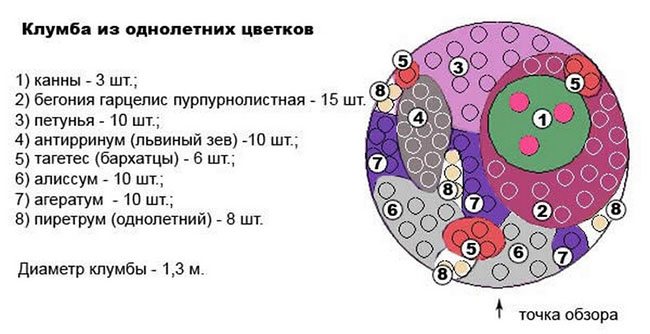

Annuals blooming profusely in the flowerbed
Direct sowing in the ground
We sow these plants that do not like transplanting immediately to a permanent growing place at the end of the second - beginning of the third month of spring or before winter. Flowers open in abundance, continuously from June-July until frost. Preferred places for summer cottages are sunny, watering and feeding may be practically absent - everything that Mother Nature gives is costly.
Often included in the Moorish lawn. They can give self-seeding.
Cornflower
Modern varieties are diverse in height (20-80 cm), degree of terry, color (not only blue, but also white, pink, burgundy, red, black). The size of the corolla is 4-8 cm. A special variety is a musky cornflower with a spicy aroma (snow-white, pinkish, lilac).
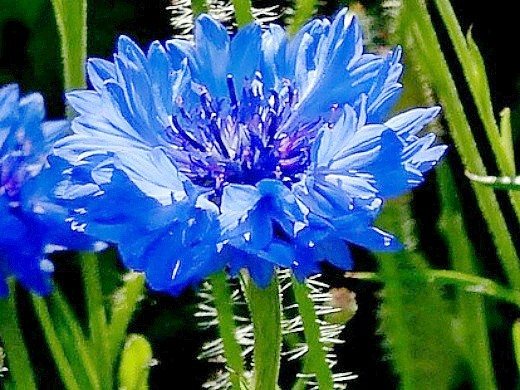

Eschsholzia
The flowers resemble miniature poppies (4-5 cm). The traditional color is orange, but there are varieties of white, yellow, pink, raspberry colors, including terry. The foliage is openwork, with a silvery tint. The bushes grow by 20-50 cm. In the absence of high competitors, they perfectly "braid" the entire area of the flower beds.
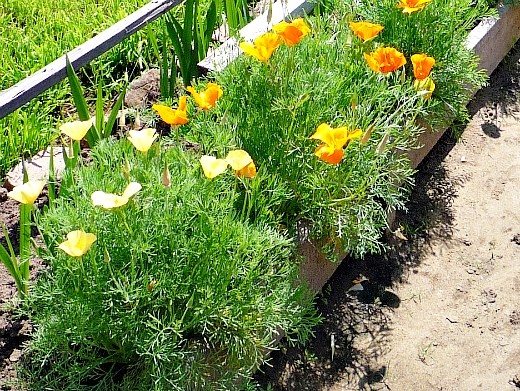

Godezia
The color scheme is similar to Escholzia, only in slightly more pastel colors. The most delicate corollas are simple and terry, like miniature roses. Their size is from 5 to 8 cm. Peduncles rise by 20-90 cm (depending on the variety).
Clarkia
Branched stems grow upwards by 30-90 cm. Carved or double flowers 3-5 cm in size sit in bunches in the leaf axils at the ends of the shoots.Petals can be of any shade of red-pink scale, as well as white, orangeish, purple-violet. Plants thrive best in slightly acidic peatlands.
Uncomplicated seedlings
Dahlias (Funny guys)
Modern varieties of annual dahlias amaze the imagination with their diversity. Height - from 25 cm to one and a half meters. Corollas - simple, with a "collar", semi-double, double, pompom, cactus. The diameter of the inflorescence is from 6 to 15 cm. Any color (except blue). There are varieties whose stems and foliage have a chocolate or burgundy hue.
Plants are photophilous and thermophilic, but the very first frost will destroy them. Seedlings develop well in outdoor summer cottages. For low-growing varieties, it is possible to sow in May to a permanent place (with a temporary shelter). Branching bushes are covered with numerous inflorescences from mid-summer to the first frosty nights.
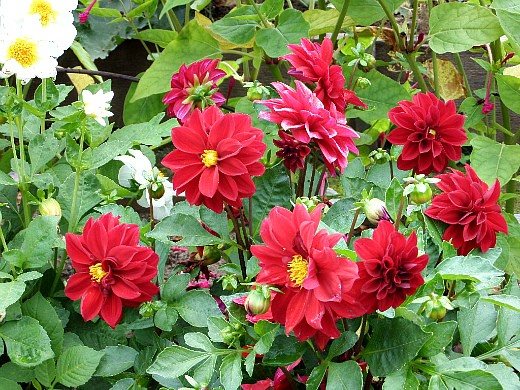

Purslane
Long twigs creep along the ground, rising above it by only 10-20 cm. A bright blooming "rug" pleases the eye all summer, although each flower has only one day of existence. Simple or double "cups" with a diameter of 3-6 cm are painted in a variety of juicy colors (except blue and blue).
Plants need very bright lighting, then they can grow even on stones, clinging to a tiny piece of land; easily tolerate heat. The roots do not tolerate stagnant moisture, do not like peat soil. They are more comfortable on poor sandy land.
We sow seedlings from February and, in fact, to April. Simple varieties are capable of self-seeding, which develops quickly and forms buds early.
Phlox Drummond
An annual phlox resembles a perennial fellow (paniculata phlox), except in the form of flowers. True, in phlox drummond they are smaller (1-4 cm), but they bloom continuously from early summer until late (in other areas) autumn, they are not afraid of the first frosts. The color of the inflorescences can be absolutely any (except black). Two-color, star-shaped and terry corollas are especially original. Juicy colors do not fade in the sun, do not fade from rains. Bushes are low (from 15 to 50 cm), but very branched; bloom with a "hat". An additional bonus is the exquisite aroma.
Sowing immediately to a permanent place is possible - before winter or in May. But for an earlier flowering, it is better to prepare the March seedlings. The culture does not tolerate shading and excess moisture.


Verbena
A rare annual can be compared in the duration of flowering with verbena. Seedlings, sown in February-March, release inflorescences during the entire warm period - spring-autumn, easily withstand September frosts. You can try sowing verbena before winter (in spring) in open ground, but in this option, the seedlings will bloom later than the early spring seedlings. For comfort, the plant needs good lighting, calcified soil, and no dampness.
The flowers of verbena are small - 1 cm (maximum - 3 cm), but they are collected in fragrant umbrellas with a diameter of 5-10 cm. Colors - all kinds (except yellow), pastel or very bright, often with a contrasting white "eye". The most popular are low-growing varieties (20-35 cm), but no less interesting are medium-sized (45-60 cm) and even giant (Verbena Bonarskaya 1.2 meters), as well as ampelous.
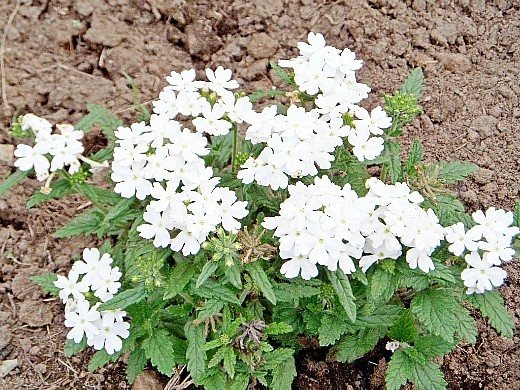

Mirabilis
The popular name is "night beauty", although in rainy or cloudy weather all flowers also open up. The plant meets the dawn with closed buds. They begin to open during the day, continue to bloom in the evening and at night, exuding a light pleasant smell. Small flowers 2-3 cm in size are painted in a variety of bright colors, not uncommon - motley and marble color. Bushes rise above the ground by 0.5 - 1 meter.
Seedlings are ready for transplanting at the age of 3-4 weeks. It is necessary to wait for warmth, negative temperatures will destroy the seedlings. Mirabilis does not tolerate swampy, acidic lands; responds well to liming. Loves sunny places.
Snapdragon (Antirrinum)
This fragrant summer adorns the garden from June (July - for the northern regions) until the coldest days. The size of a single two-lipped flower is only 2-4 cm, but dense inflorescences-brushes are formed from them. The colors are rich, varied (there is only a blue tone). Varieties of variegated, two-colored, terry, ampelous, superdwarfs (15 cm) and supergiants (100 cm) have been bred.
Seedlings begin to grow in early March, they are transferred to the ground in late spring. Bushes in the country prefer the sun or partial shade. The land needs nutritious, not too damp.


Garden balsam
Now it is fashionable to plant the newest indoor varieties of Waller and New Guinea balsams as annuals. But many have undeservedly forgotten unpretentious pyramidal garden balsams, growing 25-70 cm. Flowers are placed on the stem from top to bottom, sitting in bunches in the leaf axils. Corollas 5 cm in size are simple or terry, of various shades: white, scarlet, crimson, pink, purple. When planting them, decorating a summer cottage flower bed for most of the summer and early autumn will be guaranteed to us. Balsams, including stunted ones creeping on the ground, like a little shading and regular watering. Especially decorative in rainy seasons. In this case, the soil needs permeable, without stagnant water. We begin to grow seedlings in March - April.
Osteospermum (Cape daisy, African chamomile)
The flower is similar to a chamomile, but in its nobility of appearance it resembles a gerbera. Bushes delight with abundant flowering until the autumn cold. The varieties are undersized (25-30 cm), medium-sized and high (from 0.7 to 1 meter). Lilac, purple, blue, pink and white color of corollas is more often found, less often - orange and yellow. There are exotic varieties with petals in the form of "spoons" - flattened from the sides in the central part.
We begin to grow seedlings in early or mid-spring; especially impatient flower growers - already in January-February (with additional lighting). We move the plants to the dacha flower bed after frost - to a sunny place with nutritious soil.
Celosia
There are two types of cellosia - pinnate (paniculate) and comb. Each is gorgeous in its own way.
The inflorescences of the crested celosia resemble corrugated rooster combs or fancy corals. Plant height is 30-60 cm.
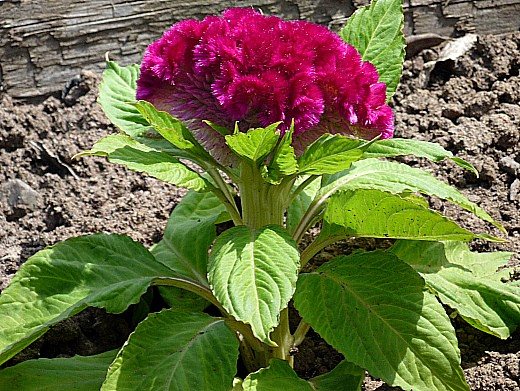

The feathery celosia blooms with fluffy panicles. There is also a spiky variety with narrower and more elongated inflorescences. Growth varies greatly between varieties - from 15 cm to 1 meter.
Celosia inflorescences are painted in shades of red-yellow-orange colors; there are also variegated (multicolored) and purple. Varieties with purple foliage are especially decorative.


Plants love well-lit areas and fertilized soil. Sowing for seedlings is necessary no later than the first decade of April.
Petunia
Some petunias are quite capricious, demanding on nutrition. But there are many unpretentious varieties. From them you can collect your seeds annually, sowing seedlings in March-April. Compact, fragrant plants in a variety of colors will adorn the sunny flower bed during the summer. They will enjoy the simple care: timely removal of faded corollas, regular watering, standard dressing.


How to plant bulbocodium brandushka
Corms of a multicolored brandy Bulbocodium versicolor photo
This is a simple matter: the corms are planted in late autumn in islands, at a distance of 10-15 cm from each other, to a depth of no more than 2-3 corm diameters. After planting, it is better to mulch the flower bed: this way the moisture will retain better, and the soil itself will become looser, filled with air.
Thanks to mulching, a special microcosm is created where bacteria and other living organisms interact, including earthworms. So the roots of the brandy will be supplied with much more nutrients, and the growing conditions will resemble natural.In the spring, you will see seedlings and delicate flowers that can be left without replanting for about 5-6 years.
Reproduction, planting and care
To grow a spring bulbodium, you need to know the basic rules for planting and caring for it. This will allow you to admire this plant for a long time in your own garden.
For reproduction, brandy use daughter bulbs, which are formed annually. In addition, it is necessary to transplant the bush itself once every 5 years. This should be done after the leaves die off. The nest should be dug out and dried a little. The babies are separated from the mother's bulb and planted in fertilized soil. The optimum depth is 6 cm. The distance between plants should be at least 10 cm.
Sometimes the Bulbocodium is grown from seed. But this is a complex process and takes more time. Before the first flowering, 6 years must pass after sowing.
The seeds are placed in soil immediately after harvest. The best place to do this is in the shade of the trees. For the winter, it must be covered with leaves, which must be removed in the spring. The land needs to be loosened and weeds removed. It is very important when choosing a site to avoid areas where melt and rain water stagnate. In conditions of high humidity, the plant can be attacked by fungus or rot.
When growing a brandy from seeds, shoots do not appear immediately. Sometimes this happens in the second and third year. This plant does not need frequent watering - this should be done only during drought and no more than once a week.
Complex fertilizers are used for feeding. Their frequency is 1 time per year. Organic fertilizers cannot be used for feeding, since fungal diseases can develop because of them. Mulching is carried out using sawdust or needles.
After the aerial parts of the brandu have dried out, the dried parts must be removed. In this case, it is worth using a fan rake, or even better, do it with your hands so as not to pull out the onion.
It is not necessary to cover the brandy before the onset of winter - it is resistant to cold. It will be enough to put an additional layer of mulch in the fall.
Blossoming of multicolored brandy:
Constant doesn't mean boring
Evergreens, due to their stability, are often mistaken for the most boring category of garden plants. But winter-green beauties are able to surprise not only with the crown that is preserved for the winter, but also with an inimitable variety. The assortment of such plants is by no means limited to conifers, and among the latter there are non-standard varieties and inimitable originals. Plants with unusual appearance for evergreen crops are by no means uncommon. Not only balls and figures of yew and boxwood, hedges of laurel and cypress, boring ordinary spruces, holly, fir, junipers, pines and euonymus are limited to their assortment. In some you will be able to observe unexpectedly powerful flowering, in others - to enjoy the catchy needles or leaves, and still others will surprise you with the compact size and picturesque beauty of the "mini" format.
The range of evergreens allows everyone to find the right solution for almost any artistic challenge. Diversity concerns not only aesthetic qualities, but also height, size, growth rate. For small gardens, excellent alternatives can be found that, even at a considerable age, will not take up much area.
The prickly loch (Elaeagnus pungens).
Let's get to know the most original and unusual of the evergreen beauties closer
Types and varieties
There are only two bulbocodium species, both of which are cultivated as indoor flowers for outdoor use, characterized by ease of maintenance and cultivation.
Multicolored brandu
The second name of this species is Russian brandy. This is due to the distribution area, which covers the entire European part of Russia, Ukraine and Belarus. In addition, it is rarely found in the Mediterranean regions.
Appears in March-April in open areas of forest-steppe zones. It is often confused with meadow crocus, since the color of the petals and the shape of the inflorescence are very similar. Flowers about 6-7 cm in diameter, located almost on the surface of the earth. Around the places where the multi-colored bulbocodium blooms, there is always a pleasant aroma that attracts the first insects.
After a long flowering, a fruit is formed in the form of a box, pointed upwards, inside which seeds ripen for a month.
This species is endangered, as its natural habitats are sharply reduced. Often, plantings also suffer from human hands. It is difficult to meet this herbaceous plant in the wild, therefore the multicolored bulbokodium is included in the Red Book of the Russian Federation and is protected by law.
Spring brandy
The natural habitats of this species are Moldova and the Crimea, it is rarely found in natural conditions in the Belgorod region. In this species, the size of the flowers is slightly larger than that of the previous one, and is 7-8 cm. The petals can be thinner and more graceful, and the inflorescence because of this resembles a star with dropped edges.
They are more demanding on the presence of light and sufficient illumination, without this parameter they may not form buds. In this case, the growing season is reduced to the appearance of leaf plates, which dry out after a month and a half.
Recently, there has been a tendency towards a massive reduction in specimens in nature, therefore the species is simultaneously listed in the Red Book of the Russian Federation and Ukraine.
Cultivated for home cultivation in light areas or in partial shade as a flower, easy to care for and does not require much time. In addition, it is often used for winter or spring forcing. You can find flowering specimens in flower shops during New Year's Eve and before March 8.
There is a botanical species called Narcissus brandu. It is often confused with the bulbokodium, but this herb belongs to a different genus and family, has a different morphology, distribution and principles of care.

